Ethical Issues of Robotics and Artificial Intelligence in Business Organizations and Society
VerifiedAdded on 2023/02/01
|23
|5595
|37
AI Summary
This research proposal explores the ethical issues of robotics and artificial intelligence in business organizations and society. It discusses the impact of these technologies and the need for ethical considerations. The proposal includes sections on background, research questions, literature review, methodology review, and more. It is for the IMAT5262 Research, Ethics & Professionalism in Computing course at De Montfort University.
Contribute Materials
Your contribution can guide someone’s learning journey. Share your
documents today.
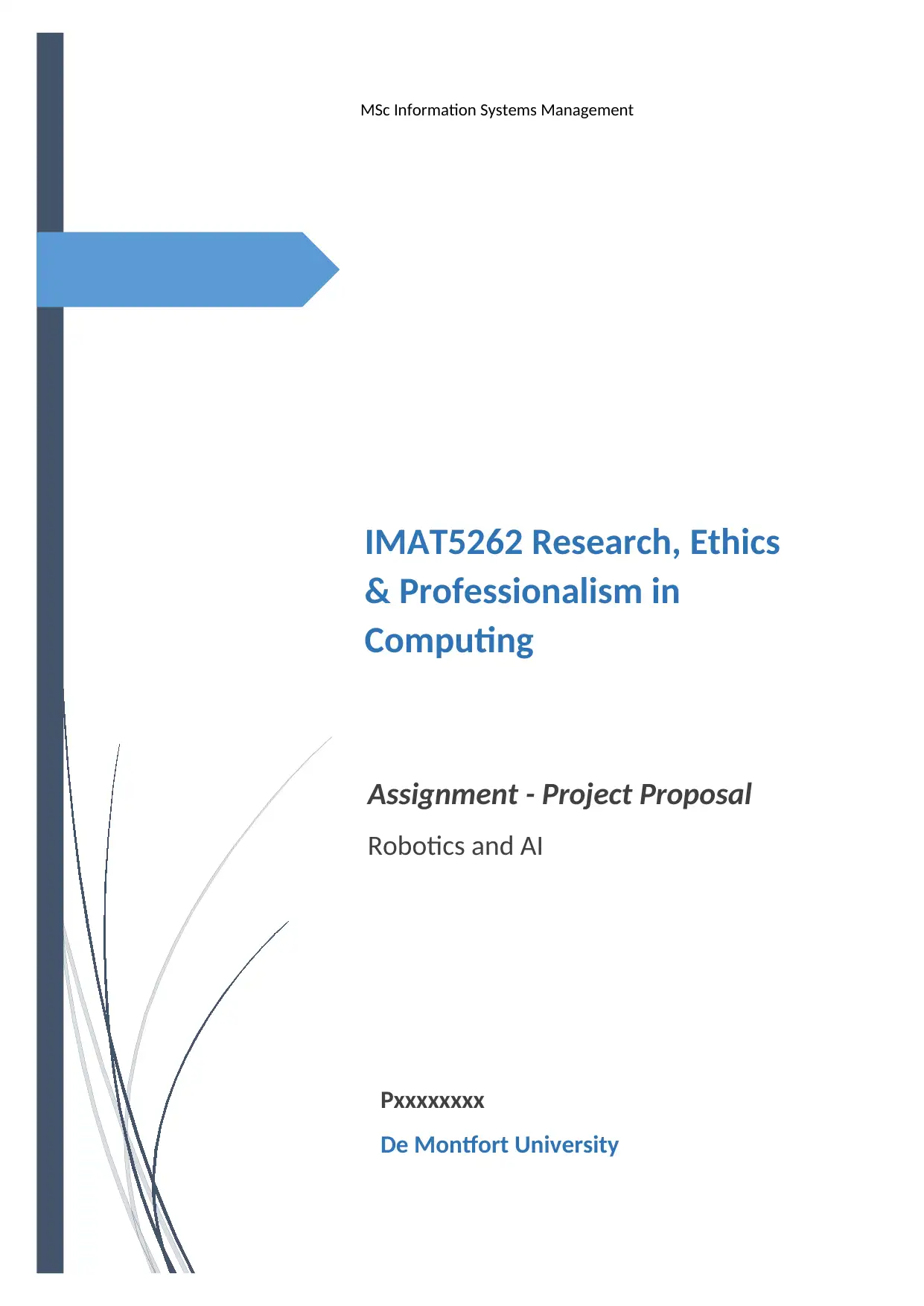
MSc Information Systems Management
IMAT5262 Research, Ethics
& Professionalism in
Computing
Assignment - Project Proposal
Robotics and AI
Pxxxxxxxx
De Montfort University
IMAT5262 Research, Ethics
& Professionalism in
Computing
Assignment - Project Proposal
Robotics and AI
Pxxxxxxxx
De Montfort University
Secure Best Marks with AI Grader
Need help grading? Try our AI Grader for instant feedback on your assignments.
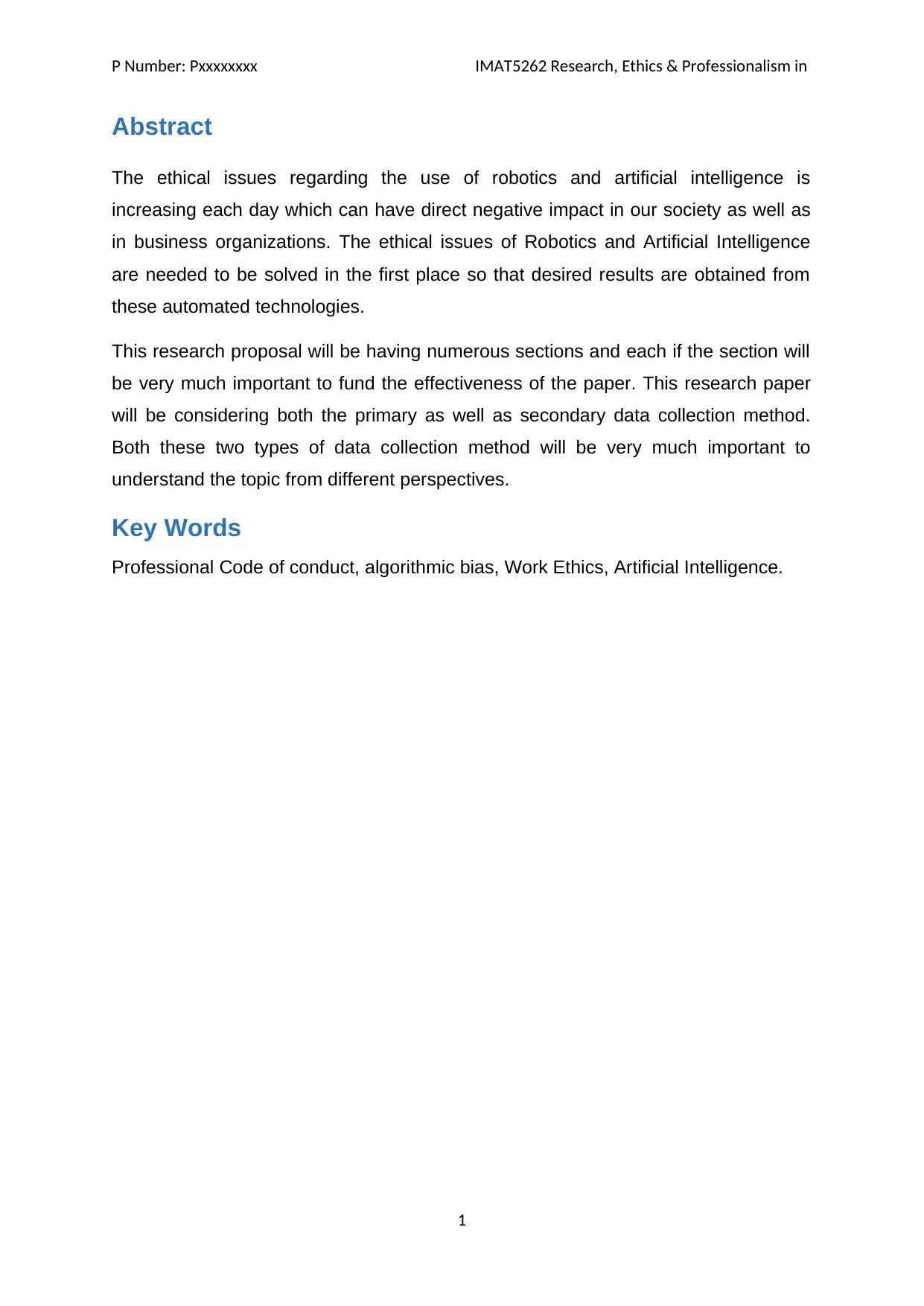
P Number: Pxxxxxxxx IMAT5262 Research, Ethics & Professionalism in
Abstract
The ethical issues regarding the use of robotics and artificial intelligence is
increasing each day which can have direct negative impact in our society as well as
in business organizations. The ethical issues of Robotics and Artificial Intelligence
are needed to be solved in the first place so that desired results are obtained from
these automated technologies.
This research proposal will be having numerous sections and each if the section will
be very much important to fund the effectiveness of the paper. This research paper
will be considering both the primary as well as secondary data collection method.
Both these two types of data collection method will be very much important to
understand the topic from different perspectives.
Key Words
Professional Code of conduct, algorithmic bias, Work Ethics, Artificial Intelligence.
1
Abstract
The ethical issues regarding the use of robotics and artificial intelligence is
increasing each day which can have direct negative impact in our society as well as
in business organizations. The ethical issues of Robotics and Artificial Intelligence
are needed to be solved in the first place so that desired results are obtained from
these automated technologies.
This research proposal will be having numerous sections and each if the section will
be very much important to fund the effectiveness of the paper. This research paper
will be considering both the primary as well as secondary data collection method.
Both these two types of data collection method will be very much important to
understand the topic from different perspectives.
Key Words
Professional Code of conduct, algorithmic bias, Work Ethics, Artificial Intelligence.
1
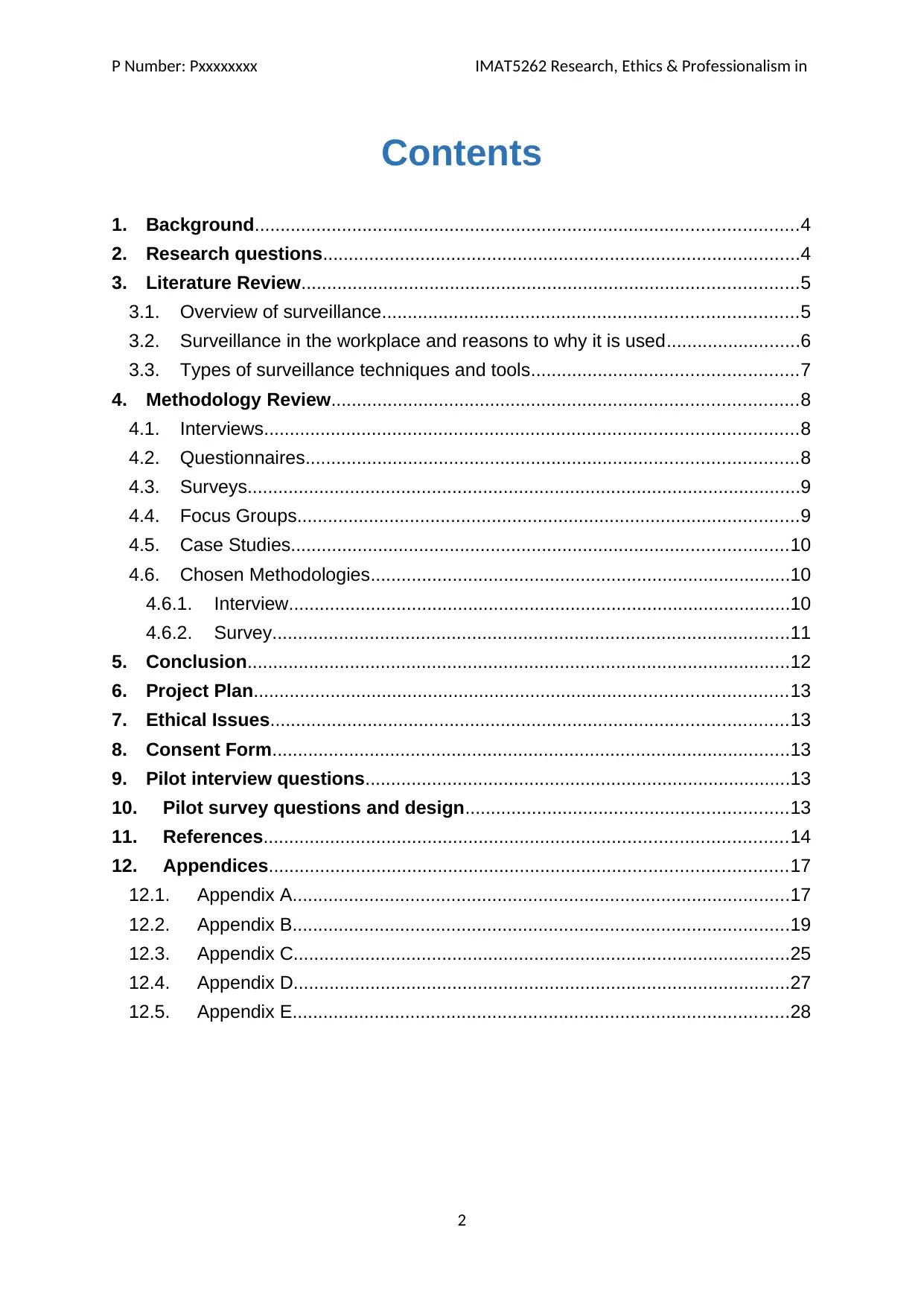
P Number: Pxxxxxxxx IMAT5262 Research, Ethics & Professionalism in
Contents
1. Background..........................................................................................................4
2. Research questions.............................................................................................4
3. Literature Review.................................................................................................5
3.1. Overview of surveillance.................................................................................5
3.2. Surveillance in the workplace and reasons to why it is used..........................6
3.3. Types of surveillance techniques and tools....................................................7
4. Methodology Review...........................................................................................8
4.1. Interviews........................................................................................................8
4.2. Questionnaires................................................................................................8
4.3. Surveys............................................................................................................9
4.4. Focus Groups..................................................................................................9
4.5. Case Studies.................................................................................................10
4.6. Chosen Methodologies..................................................................................10
4.6.1. Interview..................................................................................................10
4.6.2. Survey.....................................................................................................11
5. Conclusion..........................................................................................................12
6. Project Plan........................................................................................................13
7. Ethical Issues.....................................................................................................13
8. Consent Form.....................................................................................................13
9. Pilot interview questions...................................................................................13
10. Pilot survey questions and design...............................................................13
11. References......................................................................................................14
12. Appendices.....................................................................................................17
12.1. Appendix A.................................................................................................17
12.2. Appendix B.................................................................................................19
12.3. Appendix C.................................................................................................25
12.4. Appendix D.................................................................................................27
12.5. Appendix E.................................................................................................28
2
Contents
1. Background..........................................................................................................4
2. Research questions.............................................................................................4
3. Literature Review.................................................................................................5
3.1. Overview of surveillance.................................................................................5
3.2. Surveillance in the workplace and reasons to why it is used..........................6
3.3. Types of surveillance techniques and tools....................................................7
4. Methodology Review...........................................................................................8
4.1. Interviews........................................................................................................8
4.2. Questionnaires................................................................................................8
4.3. Surveys............................................................................................................9
4.4. Focus Groups..................................................................................................9
4.5. Case Studies.................................................................................................10
4.6. Chosen Methodologies..................................................................................10
4.6.1. Interview..................................................................................................10
4.6.2. Survey.....................................................................................................11
5. Conclusion..........................................................................................................12
6. Project Plan........................................................................................................13
7. Ethical Issues.....................................................................................................13
8. Consent Form.....................................................................................................13
9. Pilot interview questions...................................................................................13
10. Pilot survey questions and design...............................................................13
11. References......................................................................................................14
12. Appendices.....................................................................................................17
12.1. Appendix A.................................................................................................17
12.2. Appendix B.................................................................................................19
12.3. Appendix C.................................................................................................25
12.4. Appendix D.................................................................................................27
12.5. Appendix E.................................................................................................28
2
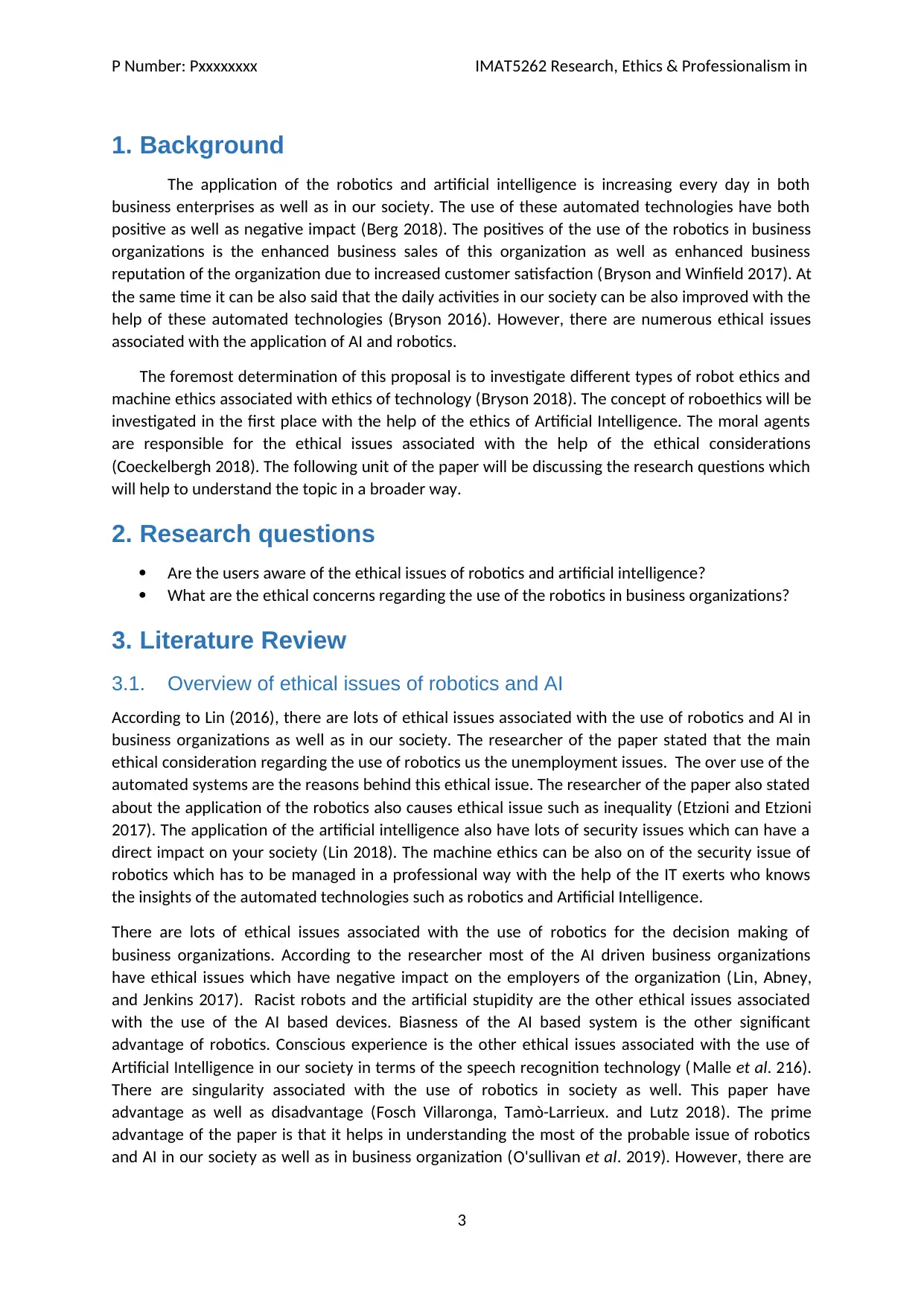
P Number: Pxxxxxxxx IMAT5262 Research, Ethics & Professionalism in
1. Background
The application of the robotics and artificial intelligence is increasing every day in both
business enterprises as well as in our society. The use of these automated technologies have both
positive as well as negative impact (Berg 2018). The positives of the use of the robotics in business
organizations is the enhanced business sales of this organization as well as enhanced business
reputation of the organization due to increased customer satisfaction (Bryson and Winfield 2017). At
the same time it can be also said that the daily activities in our society can be also improved with the
help of these automated technologies (Bryson 2016). However, there are numerous ethical issues
associated with the application of AI and robotics.
The foremost determination of this proposal is to investigate different types of robot ethics and
machine ethics associated with ethics of technology (Bryson 2018). The concept of roboethics will be
investigated in the first place with the help of the ethics of Artificial Intelligence. The moral agents
are responsible for the ethical issues associated with the help of the ethical considerations
(Coeckelbergh 2018). The following unit of the paper will be discussing the research questions which
will help to understand the topic in a broader way.
2. Research questions
Are the users aware of the ethical issues of robotics and artificial intelligence?
What are the ethical concerns regarding the use of the robotics in business organizations?
3. Literature Review
3.1. Overview of ethical issues of robotics and AI
According to Lin (2016), there are lots of ethical issues associated with the use of robotics and AI in
business organizations as well as in our society. The researcher of the paper stated that the main
ethical consideration regarding the use of robotics us the unemployment issues. The over use of the
automated systems are the reasons behind this ethical issue. The researcher of the paper also stated
about the application of the robotics also causes ethical issue such as inequality (Etzioni and Etzioni
2017). The application of the artificial intelligence also have lots of security issues which can have a
direct impact on your society (Lin 2018). The machine ethics can be also on of the security issue of
robotics which has to be managed in a professional way with the help of the IT exerts who knows
the insights of the automated technologies such as robotics and Artificial Intelligence.
There are lots of ethical issues associated with the use of robotics for the decision making of
business organizations. According to the researcher most of the AI driven business organizations
have ethical issues which have negative impact on the employers of the organization ( Lin, Abney,
and Jenkins 2017). Racist robots and the artificial stupidity are the other ethical issues associated
with the use of the AI based devices. Biasness of the AI based system is the other significant
advantage of robotics. Conscious experience is the other ethical issues associated with the use of
Artificial Intelligence in our society in terms of the speech recognition technology ( Malle et al. 216).
There are singularity associated with the use of robotics in society as well. This paper have
advantage as well as disadvantage (Fosch Villaronga, Tamò-Larrieux. and Lutz 2018). The prime
advantage of the paper is that it helps in understanding the most of the probable issue of robotics
and AI in our society as well as in business organization (O'sullivan et al. 2019). However, there are
3
1. Background
The application of the robotics and artificial intelligence is increasing every day in both
business enterprises as well as in our society. The use of these automated technologies have both
positive as well as negative impact (Berg 2018). The positives of the use of the robotics in business
organizations is the enhanced business sales of this organization as well as enhanced business
reputation of the organization due to increased customer satisfaction (Bryson and Winfield 2017). At
the same time it can be also said that the daily activities in our society can be also improved with the
help of these automated technologies (Bryson 2016). However, there are numerous ethical issues
associated with the application of AI and robotics.
The foremost determination of this proposal is to investigate different types of robot ethics and
machine ethics associated with ethics of technology (Bryson 2018). The concept of roboethics will be
investigated in the first place with the help of the ethics of Artificial Intelligence. The moral agents
are responsible for the ethical issues associated with the help of the ethical considerations
(Coeckelbergh 2018). The following unit of the paper will be discussing the research questions which
will help to understand the topic in a broader way.
2. Research questions
Are the users aware of the ethical issues of robotics and artificial intelligence?
What are the ethical concerns regarding the use of the robotics in business organizations?
3. Literature Review
3.1. Overview of ethical issues of robotics and AI
According to Lin (2016), there are lots of ethical issues associated with the use of robotics and AI in
business organizations as well as in our society. The researcher of the paper stated that the main
ethical consideration regarding the use of robotics us the unemployment issues. The over use of the
automated systems are the reasons behind this ethical issue. The researcher of the paper also stated
about the application of the robotics also causes ethical issue such as inequality (Etzioni and Etzioni
2017). The application of the artificial intelligence also have lots of security issues which can have a
direct impact on your society (Lin 2018). The machine ethics can be also on of the security issue of
robotics which has to be managed in a professional way with the help of the IT exerts who knows
the insights of the automated technologies such as robotics and Artificial Intelligence.
There are lots of ethical issues associated with the use of robotics for the decision making of
business organizations. According to the researcher most of the AI driven business organizations
have ethical issues which have negative impact on the employers of the organization ( Lin, Abney,
and Jenkins 2017). Racist robots and the artificial stupidity are the other ethical issues associated
with the use of the AI based devices. Biasness of the AI based system is the other significant
advantage of robotics. Conscious experience is the other ethical issues associated with the use of
Artificial Intelligence in our society in terms of the speech recognition technology ( Malle et al. 216).
There are singularity associated with the use of robotics in society as well. This paper have
advantage as well as disadvantage (Fosch Villaronga, Tamò-Larrieux. and Lutz 2018). The prime
advantage of the paper is that it helps in understanding the most of the probable issue of robotics
and AI in our society as well as in business organization (O'sullivan et al. 2019). However, there are
3
Secure Best Marks with AI Grader
Need help grading? Try our AI Grader for instant feedback on your assignments.
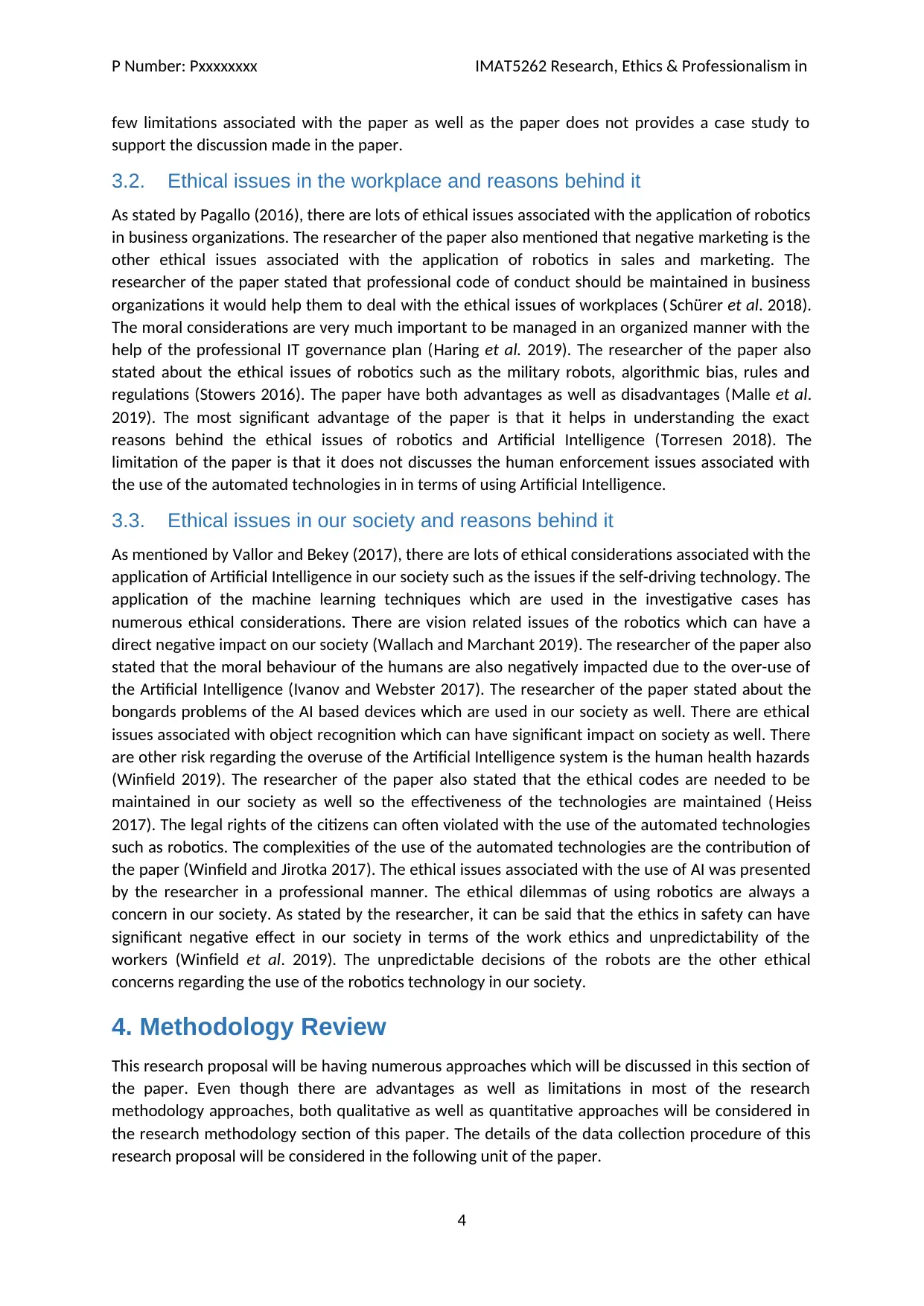
P Number: Pxxxxxxxx IMAT5262 Research, Ethics & Professionalism in
few limitations associated with the paper as well as the paper does not provides a case study to
support the discussion made in the paper.
3.2. Ethical issues in the workplace and reasons behind it
As stated by Pagallo (2016), there are lots of ethical issues associated with the application of robotics
in business organizations. The researcher of the paper also mentioned that negative marketing is the
other ethical issues associated with the application of robotics in sales and marketing. The
researcher of the paper stated that professional code of conduct should be maintained in business
organizations it would help them to deal with the ethical issues of workplaces ( Schürer et al. 2018).
The moral considerations are very much important to be managed in an organized manner with the
help of the professional IT governance plan (Haring et al. 2019). The researcher of the paper also
stated about the ethical issues of robotics such as the military robots, algorithmic bias, rules and
regulations (Stowers 2016). The paper have both advantages as well as disadvantages (Malle et al.
2019). The most significant advantage of the paper is that it helps in understanding the exact
reasons behind the ethical issues of robotics and Artificial Intelligence (Torresen 2018). The
limitation of the paper is that it does not discusses the human enforcement issues associated with
the use of the automated technologies in in terms of using Artificial Intelligence.
3.3. Ethical issues in our society and reasons behind it
As mentioned by Vallor and Bekey (2017), there are lots of ethical considerations associated with the
application of Artificial Intelligence in our society such as the issues if the self-driving technology. The
application of the machine learning techniques which are used in the investigative cases has
numerous ethical considerations. There are vision related issues of the robotics which can have a
direct negative impact on our society (Wallach and Marchant 2019). The researcher of the paper also
stated that the moral behaviour of the humans are also negatively impacted due to the over-use of
the Artificial Intelligence (Ivanov and Webster 2017). The researcher of the paper stated about the
bongards problems of the AI based devices which are used in our society as well. There are ethical
issues associated with object recognition which can have significant impact on society as well. There
are other risk regarding the overuse of the Artificial Intelligence system is the human health hazards
(Winfield 2019). The researcher of the paper also stated that the ethical codes are needed to be
maintained in our society as well so the effectiveness of the technologies are maintained ( Heiss
2017). The legal rights of the citizens can often violated with the use of the automated technologies
such as robotics. The complexities of the use of the automated technologies are the contribution of
the paper (Winfield and Jirotka 2017). The ethical issues associated with the use of AI was presented
by the researcher in a professional manner. The ethical dilemmas of using robotics are always a
concern in our society. As stated by the researcher, it can be said that the ethics in safety can have
significant negative effect in our society in terms of the work ethics and unpredictability of the
workers (Winfield et al. 2019). The unpredictable decisions of the robots are the other ethical
concerns regarding the use of the robotics technology in our society.
4. Methodology Review
This research proposal will be having numerous approaches which will be discussed in this section of
the paper. Even though there are advantages as well as limitations in most of the research
methodology approaches, both qualitative as well as quantitative approaches will be considered in
the research methodology section of this paper. The details of the data collection procedure of this
research proposal will be considered in the following unit of the paper.
4
few limitations associated with the paper as well as the paper does not provides a case study to
support the discussion made in the paper.
3.2. Ethical issues in the workplace and reasons behind it
As stated by Pagallo (2016), there are lots of ethical issues associated with the application of robotics
in business organizations. The researcher of the paper also mentioned that negative marketing is the
other ethical issues associated with the application of robotics in sales and marketing. The
researcher of the paper stated that professional code of conduct should be maintained in business
organizations it would help them to deal with the ethical issues of workplaces ( Schürer et al. 2018).
The moral considerations are very much important to be managed in an organized manner with the
help of the professional IT governance plan (Haring et al. 2019). The researcher of the paper also
stated about the ethical issues of robotics such as the military robots, algorithmic bias, rules and
regulations (Stowers 2016). The paper have both advantages as well as disadvantages (Malle et al.
2019). The most significant advantage of the paper is that it helps in understanding the exact
reasons behind the ethical issues of robotics and Artificial Intelligence (Torresen 2018). The
limitation of the paper is that it does not discusses the human enforcement issues associated with
the use of the automated technologies in in terms of using Artificial Intelligence.
3.3. Ethical issues in our society and reasons behind it
As mentioned by Vallor and Bekey (2017), there are lots of ethical considerations associated with the
application of Artificial Intelligence in our society such as the issues if the self-driving technology. The
application of the machine learning techniques which are used in the investigative cases has
numerous ethical considerations. There are vision related issues of the robotics which can have a
direct negative impact on our society (Wallach and Marchant 2019). The researcher of the paper also
stated that the moral behaviour of the humans are also negatively impacted due to the over-use of
the Artificial Intelligence (Ivanov and Webster 2017). The researcher of the paper stated about the
bongards problems of the AI based devices which are used in our society as well. There are ethical
issues associated with object recognition which can have significant impact on society as well. There
are other risk regarding the overuse of the Artificial Intelligence system is the human health hazards
(Winfield 2019). The researcher of the paper also stated that the ethical codes are needed to be
maintained in our society as well so the effectiveness of the technologies are maintained ( Heiss
2017). The legal rights of the citizens can often violated with the use of the automated technologies
such as robotics. The complexities of the use of the automated technologies are the contribution of
the paper (Winfield and Jirotka 2017). The ethical issues associated with the use of AI was presented
by the researcher in a professional manner. The ethical dilemmas of using robotics are always a
concern in our society. As stated by the researcher, it can be said that the ethics in safety can have
significant negative effect in our society in terms of the work ethics and unpredictability of the
workers (Winfield et al. 2019). The unpredictable decisions of the robots are the other ethical
concerns regarding the use of the robotics technology in our society.
4. Methodology Review
This research proposal will be having numerous approaches which will be discussed in this section of
the paper. Even though there are advantages as well as limitations in most of the research
methodology approaches, both qualitative as well as quantitative approaches will be considered in
the research methodology section of this paper. The details of the data collection procedure of this
research proposal will be considered in the following unit of the paper.
4
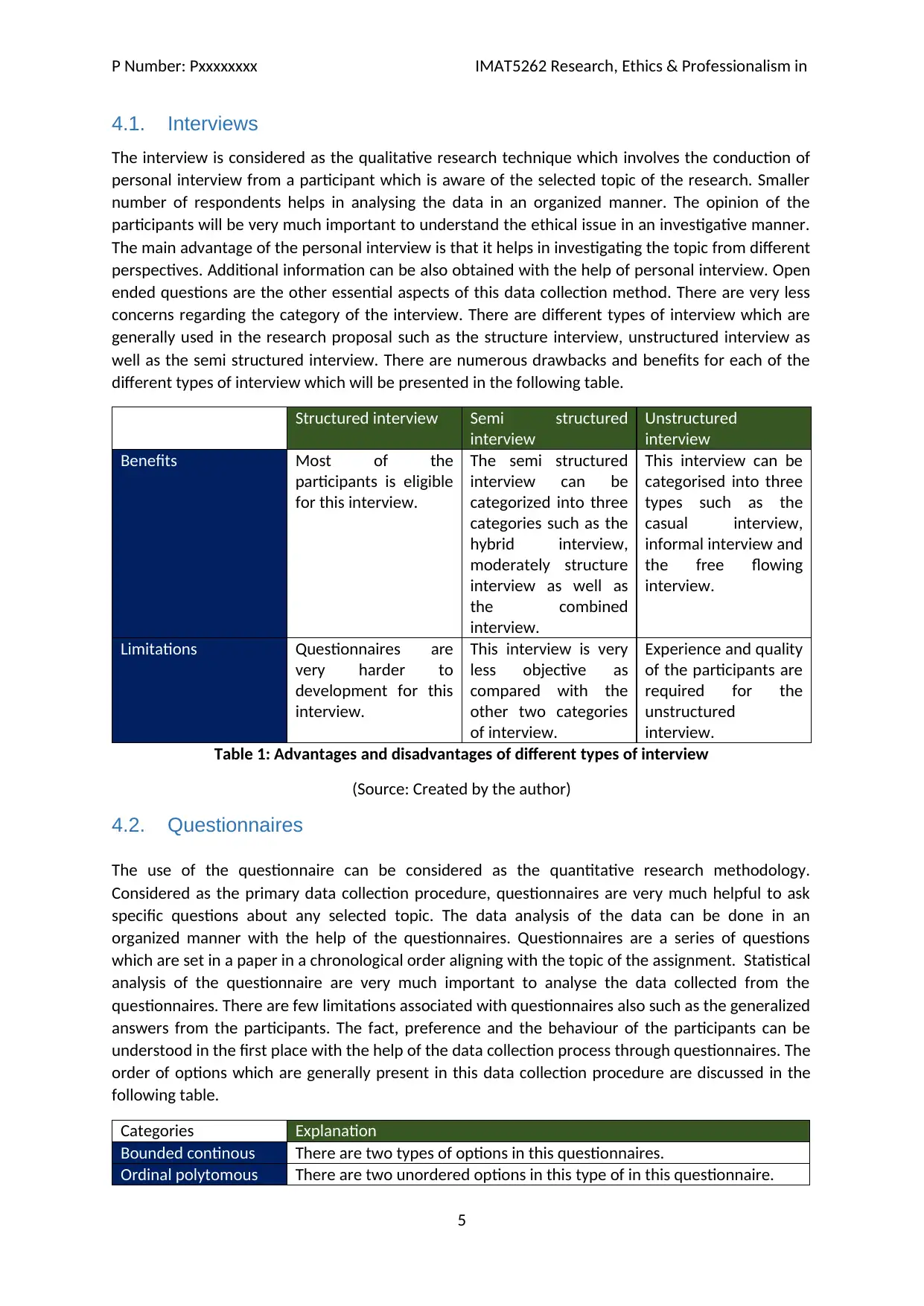
P Number: Pxxxxxxxx IMAT5262 Research, Ethics & Professionalism in
4.1. Interviews
The interview is considered as the qualitative research technique which involves the conduction of
personal interview from a participant which is aware of the selected topic of the research. Smaller
number of respondents helps in analysing the data in an organized manner. The opinion of the
participants will be very much important to understand the ethical issue in an investigative manner.
The main advantage of the personal interview is that it helps in investigating the topic from different
perspectives. Additional information can be also obtained with the help of personal interview. Open
ended questions are the other essential aspects of this data collection method. There are very less
concerns regarding the category of the interview. There are different types of interview which are
generally used in the research proposal such as the structure interview, unstructured interview as
well as the semi structured interview. There are numerous drawbacks and benefits for each of the
different types of interview which will be presented in the following table.
Structured interview Semi structured
interview
Unstructured
interview
Benefits Most of the
participants is eligible
for this interview.
The semi structured
interview can be
categorized into three
categories such as the
hybrid interview,
moderately structure
interview as well as
the combined
interview.
This interview can be
categorised into three
types such as the
casual interview,
informal interview and
the free flowing
interview.
Limitations Questionnaires are
very harder to
development for this
interview.
This interview is very
less objective as
compared with the
other two categories
of interview.
Experience and quality
of the participants are
required for the
unstructured
interview.
Table 1: Advantages and disadvantages of different types of interview
(Source: Created by the author)
4.2. Questionnaires
The use of the questionnaire can be considered as the quantitative research methodology.
Considered as the primary data collection procedure, questionnaires are very much helpful to ask
specific questions about any selected topic. The data analysis of the data can be done in an
organized manner with the help of the questionnaires. Questionnaires are a series of questions
which are set in a paper in a chronological order aligning with the topic of the assignment. Statistical
analysis of the questionnaire are very much important to analyse the data collected from the
questionnaires. There are few limitations associated with questionnaires also such as the generalized
answers from the participants. The fact, preference and the behaviour of the participants can be
understood in the first place with the help of the data collection process through questionnaires. The
order of options which are generally present in this data collection procedure are discussed in the
following table.
Categories Explanation
Bounded continous There are two types of options in this questionnaires.
Ordinal polytomous There are two unordered options in this type of in this questionnaire.
5
4.1. Interviews
The interview is considered as the qualitative research technique which involves the conduction of
personal interview from a participant which is aware of the selected topic of the research. Smaller
number of respondents helps in analysing the data in an organized manner. The opinion of the
participants will be very much important to understand the ethical issue in an investigative manner.
The main advantage of the personal interview is that it helps in investigating the topic from different
perspectives. Additional information can be also obtained with the help of personal interview. Open
ended questions are the other essential aspects of this data collection method. There are very less
concerns regarding the category of the interview. There are different types of interview which are
generally used in the research proposal such as the structure interview, unstructured interview as
well as the semi structured interview. There are numerous drawbacks and benefits for each of the
different types of interview which will be presented in the following table.
Structured interview Semi structured
interview
Unstructured
interview
Benefits Most of the
participants is eligible
for this interview.
The semi structured
interview can be
categorized into three
categories such as the
hybrid interview,
moderately structure
interview as well as
the combined
interview.
This interview can be
categorised into three
types such as the
casual interview,
informal interview and
the free flowing
interview.
Limitations Questionnaires are
very harder to
development for this
interview.
This interview is very
less objective as
compared with the
other two categories
of interview.
Experience and quality
of the participants are
required for the
unstructured
interview.
Table 1: Advantages and disadvantages of different types of interview
(Source: Created by the author)
4.2. Questionnaires
The use of the questionnaire can be considered as the quantitative research methodology.
Considered as the primary data collection procedure, questionnaires are very much helpful to ask
specific questions about any selected topic. The data analysis of the data can be done in an
organized manner with the help of the questionnaires. Questionnaires are a series of questions
which are set in a paper in a chronological order aligning with the topic of the assignment. Statistical
analysis of the questionnaire are very much important to analyse the data collected from the
questionnaires. There are few limitations associated with questionnaires also such as the generalized
answers from the participants. The fact, preference and the behaviour of the participants can be
understood in the first place with the help of the data collection process through questionnaires. The
order of options which are generally present in this data collection procedure are discussed in the
following table.
Categories Explanation
Bounded continous There are two types of options in this questionnaires.
Ordinal polytomous There are two unordered options in this type of in this questionnaire.
5
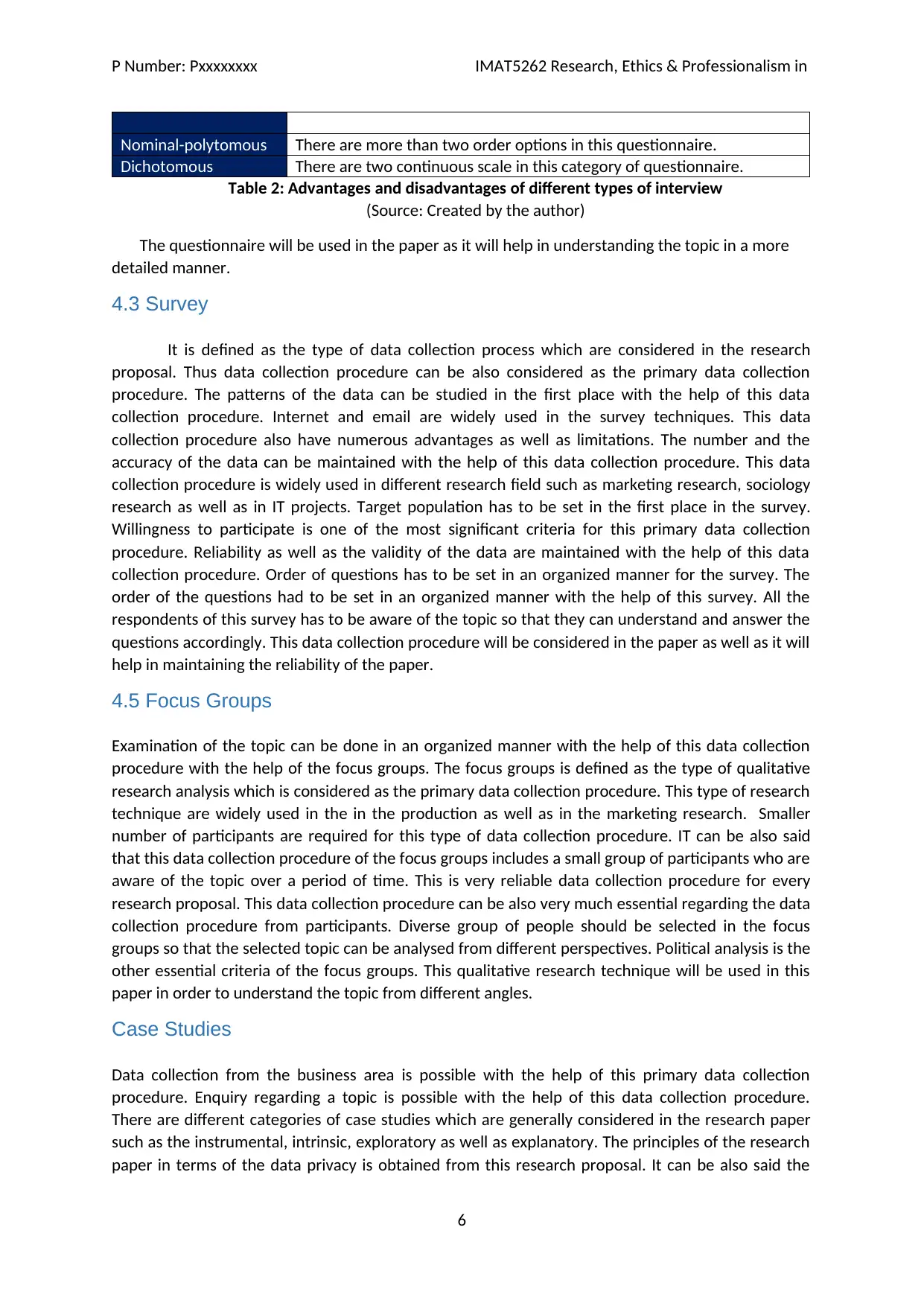
P Number: Pxxxxxxxx IMAT5262 Research, Ethics & Professionalism in
Nominal-polytomous There are more than two order options in this questionnaire.
Dichotomous There are two continuous scale in this category of questionnaire.
Table 2: Advantages and disadvantages of different types of interview
(Source: Created by the author)
The questionnaire will be used in the paper as it will help in understanding the topic in a more
detailed manner.
4.3 Survey
It is defined as the type of data collection process which are considered in the research
proposal. Thus data collection procedure can be also considered as the primary data collection
procedure. The patterns of the data can be studied in the first place with the help of this data
collection procedure. Internet and email are widely used in the survey techniques. This data
collection procedure also have numerous advantages as well as limitations. The number and the
accuracy of the data can be maintained with the help of this data collection procedure. This data
collection procedure is widely used in different research field such as marketing research, sociology
research as well as in IT projects. Target population has to be set in the first place in the survey.
Willingness to participate is one of the most significant criteria for this primary data collection
procedure. Reliability as well as the validity of the data are maintained with the help of this data
collection procedure. Order of questions has to be set in an organized manner for the survey. The
order of the questions had to be set in an organized manner with the help of this survey. All the
respondents of this survey has to be aware of the topic so that they can understand and answer the
questions accordingly. This data collection procedure will be considered in the paper as well as it will
help in maintaining the reliability of the paper.
4.5 Focus Groups
Examination of the topic can be done in an organized manner with the help of this data collection
procedure with the help of the focus groups. The focus groups is defined as the type of qualitative
research analysis which is considered as the primary data collection procedure. This type of research
technique are widely used in the in the production as well as in the marketing research. Smaller
number of participants are required for this type of data collection procedure. IT can be also said
that this data collection procedure of the focus groups includes a small group of participants who are
aware of the topic over a period of time. This is very reliable data collection procedure for every
research proposal. This data collection procedure can be also very much essential regarding the data
collection procedure from participants. Diverse group of people should be selected in the focus
groups so that the selected topic can be analysed from different perspectives. Political analysis is the
other essential criteria of the focus groups. This qualitative research technique will be used in this
paper in order to understand the topic from different angles.
Case Studies
Data collection from the business area is possible with the help of this primary data collection
procedure. Enquiry regarding a topic is possible with the help of this data collection procedure.
There are different categories of case studies which are generally considered in the research paper
such as the instrumental, intrinsic, exploratory as well as explanatory. The principles of the research
paper in terms of the data privacy is obtained from this research proposal. It can be also said the
6
Nominal-polytomous There are more than two order options in this questionnaire.
Dichotomous There are two continuous scale in this category of questionnaire.
Table 2: Advantages and disadvantages of different types of interview
(Source: Created by the author)
The questionnaire will be used in the paper as it will help in understanding the topic in a more
detailed manner.
4.3 Survey
It is defined as the type of data collection process which are considered in the research
proposal. Thus data collection procedure can be also considered as the primary data collection
procedure. The patterns of the data can be studied in the first place with the help of this data
collection procedure. Internet and email are widely used in the survey techniques. This data
collection procedure also have numerous advantages as well as limitations. The number and the
accuracy of the data can be maintained with the help of this data collection procedure. This data
collection procedure is widely used in different research field such as marketing research, sociology
research as well as in IT projects. Target population has to be set in the first place in the survey.
Willingness to participate is one of the most significant criteria for this primary data collection
procedure. Reliability as well as the validity of the data are maintained with the help of this data
collection procedure. Order of questions has to be set in an organized manner for the survey. The
order of the questions had to be set in an organized manner with the help of this survey. All the
respondents of this survey has to be aware of the topic so that they can understand and answer the
questions accordingly. This data collection procedure will be considered in the paper as well as it will
help in maintaining the reliability of the paper.
4.5 Focus Groups
Examination of the topic can be done in an organized manner with the help of this data collection
procedure with the help of the focus groups. The focus groups is defined as the type of qualitative
research analysis which is considered as the primary data collection procedure. This type of research
technique are widely used in the in the production as well as in the marketing research. Smaller
number of participants are required for this type of data collection procedure. IT can be also said
that this data collection procedure of the focus groups includes a small group of participants who are
aware of the topic over a period of time. This is very reliable data collection procedure for every
research proposal. This data collection procedure can be also very much essential regarding the data
collection procedure from participants. Diverse group of people should be selected in the focus
groups so that the selected topic can be analysed from different perspectives. Political analysis is the
other essential criteria of the focus groups. This qualitative research technique will be used in this
paper in order to understand the topic from different angles.
Case Studies
Data collection from the business area is possible with the help of this primary data collection
procedure. Enquiry regarding a topic is possible with the help of this data collection procedure.
There are different categories of case studies which are generally considered in the research paper
such as the instrumental, intrinsic, exploratory as well as explanatory. The principles of the research
paper in terms of the data privacy is obtained from this research proposal. It can be also said the
6
Paraphrase This Document
Need a fresh take? Get an instant paraphrase of this document with our AI Paraphraser

P Number: Pxxxxxxxx IMAT5262 Research, Ethics & Professionalism in
transparency of the paper will be maintained with the help of this primary data collection procedure.
The close-up and in-depth knowledge can be obtained with the help of this data collection
technique. It can be also said that this data collection. There are advantages as well as disadvantages
associated with this primary data collection technique. The primary benefit of this data collection
technique is that it helps in understand any complex topics. The settings and documents which are
needed for this data collection procedure is not very much complex in nature as compared with the
working principles of the other primary data collection procedures.
Chosen Methodologies
Interview
Expansion of the interview is very much important for the maintaining the effectiveness of this
research paper as there may be chances that more insights of ethics associated with Artificial
Intelligence and robotics. The participants of the interview must be aware of the topic in a detailed
manner so that they can effectively contribute to the effectiveness of the paper. Information from
personal opinion and obtained with the help of this interview. Any questions related to the topic can
be asked with the help of an interview. Personal face to face interview in the natural environment of
the participant will allows them to answer all the questions in a professional manner. All the
questions has to be fully understood by the participants in order to answer the questions in an
organized manner. The personnel interview will be conducted on 20 participants from different IT
organizations who uses robotics and Artificial Intelligence in their workplaces. Out of these 20
participants 10 of them will be from a different country. These divisions are made in order to avoid
any kinds of generalised answers. The duration of each of the interview will be 20mins long.
Survey
It is defined as one of the easiest data collection procedure. It can be said that both technical as well
as nontechnical participants can be part of this data collection procedure. Detailed information can
be obtained with the help of this qualitative research method. This research method can be very
much important to understand numerous other issues associated with the ethical issues of Artificial
Intelligence and robotics. The time required for collected the data with the help of this data
collection prices is much less than the other primary data collection procedures. Effectiveness of the
survey of this research paper will be maintained as the survey form will be shared with both
participants using robotics in their workplaces as well participants who uses Artificial Intelligence in
in their daily life. Participants from numerous IT organizations will be considered as a part of this
data collection process.
5. Conclusion
The research paper helps in concluding that there are numerous ethical issue associated with the
use of the robotics and Artificial Intelligence in both workplaces as well as in our society. This
research paper is very much reliable in nature as it considered both the secondary as well as the
primary data collection procedure. The data collection procedure of this research paper is very much
important to understand the research questions which presented in the earlier units of the paper. All
the activities of the project will be subdivided into categories so that transparency if the paper is
maintained.
7
transparency of the paper will be maintained with the help of this primary data collection procedure.
The close-up and in-depth knowledge can be obtained with the help of this data collection
technique. It can be also said that this data collection. There are advantages as well as disadvantages
associated with this primary data collection technique. The primary benefit of this data collection
technique is that it helps in understand any complex topics. The settings and documents which are
needed for this data collection procedure is not very much complex in nature as compared with the
working principles of the other primary data collection procedures.
Chosen Methodologies
Interview
Expansion of the interview is very much important for the maintaining the effectiveness of this
research paper as there may be chances that more insights of ethics associated with Artificial
Intelligence and robotics. The participants of the interview must be aware of the topic in a detailed
manner so that they can effectively contribute to the effectiveness of the paper. Information from
personal opinion and obtained with the help of this interview. Any questions related to the topic can
be asked with the help of an interview. Personal face to face interview in the natural environment of
the participant will allows them to answer all the questions in a professional manner. All the
questions has to be fully understood by the participants in order to answer the questions in an
organized manner. The personnel interview will be conducted on 20 participants from different IT
organizations who uses robotics and Artificial Intelligence in their workplaces. Out of these 20
participants 10 of them will be from a different country. These divisions are made in order to avoid
any kinds of generalised answers. The duration of each of the interview will be 20mins long.
Survey
It is defined as one of the easiest data collection procedure. It can be said that both technical as well
as nontechnical participants can be part of this data collection procedure. Detailed information can
be obtained with the help of this qualitative research method. This research method can be very
much important to understand numerous other issues associated with the ethical issues of Artificial
Intelligence and robotics. The time required for collected the data with the help of this data
collection prices is much less than the other primary data collection procedures. Effectiveness of the
survey of this research paper will be maintained as the survey form will be shared with both
participants using robotics in their workplaces as well participants who uses Artificial Intelligence in
in their daily life. Participants from numerous IT organizations will be considered as a part of this
data collection process.
5. Conclusion
The research paper helps in concluding that there are numerous ethical issue associated with the
use of the robotics and Artificial Intelligence in both workplaces as well as in our society. This
research paper is very much reliable in nature as it considered both the secondary as well as the
primary data collection procedure. The data collection procedure of this research paper is very much
important to understand the research questions which presented in the earlier units of the paper. All
the activities of the project will be subdivided into categories so that transparency if the paper is
maintained.
7
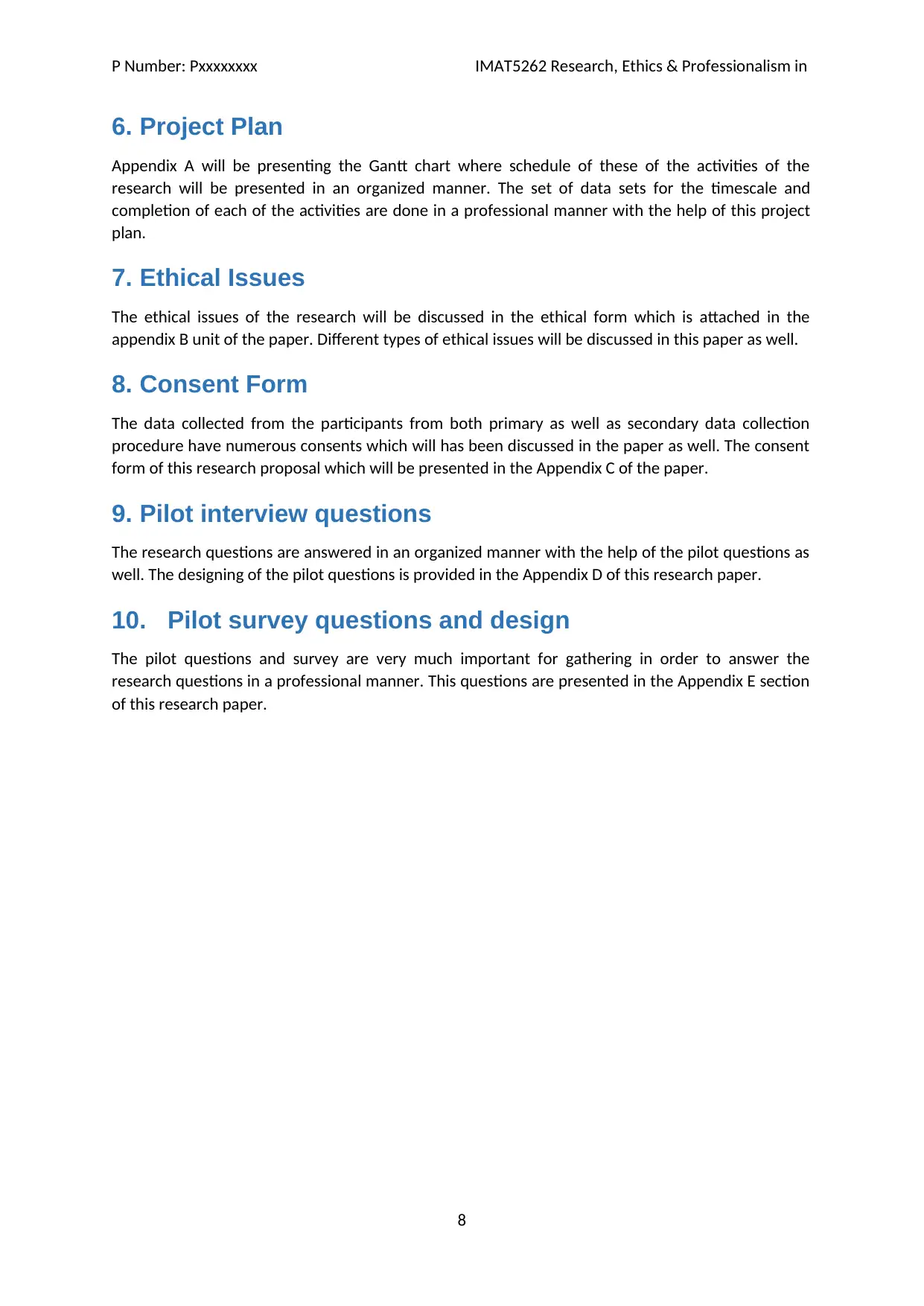
P Number: Pxxxxxxxx IMAT5262 Research, Ethics & Professionalism in
6. Project Plan
Appendix A will be presenting the Gantt chart where schedule of these of the activities of the
research will be presented in an organized manner. The set of data sets for the timescale and
completion of each of the activities are done in a professional manner with the help of this project
plan.
7. Ethical Issues
The ethical issues of the research will be discussed in the ethical form which is attached in the
appendix B unit of the paper. Different types of ethical issues will be discussed in this paper as well.
8. Consent Form
The data collected from the participants from both primary as well as secondary data collection
procedure have numerous consents which will has been discussed in the paper as well. The consent
form of this research proposal which will be presented in the Appendix C of the paper.
9. Pilot interview questions
The research questions are answered in an organized manner with the help of the pilot questions as
well. The designing of the pilot questions is provided in the Appendix D of this research paper.
10. Pilot survey questions and design
The pilot questions and survey are very much important for gathering in order to answer the
research questions in a professional manner. This questions are presented in the Appendix E section
of this research paper.
8
6. Project Plan
Appendix A will be presenting the Gantt chart where schedule of these of the activities of the
research will be presented in an organized manner. The set of data sets for the timescale and
completion of each of the activities are done in a professional manner with the help of this project
plan.
7. Ethical Issues
The ethical issues of the research will be discussed in the ethical form which is attached in the
appendix B unit of the paper. Different types of ethical issues will be discussed in this paper as well.
8. Consent Form
The data collected from the participants from both primary as well as secondary data collection
procedure have numerous consents which will has been discussed in the paper as well. The consent
form of this research proposal which will be presented in the Appendix C of the paper.
9. Pilot interview questions
The research questions are answered in an organized manner with the help of the pilot questions as
well. The designing of the pilot questions is provided in the Appendix D of this research paper.
10. Pilot survey questions and design
The pilot questions and survey are very much important for gathering in order to answer the
research questions in a professional manner. This questions are presented in the Appendix E section
of this research paper.
8
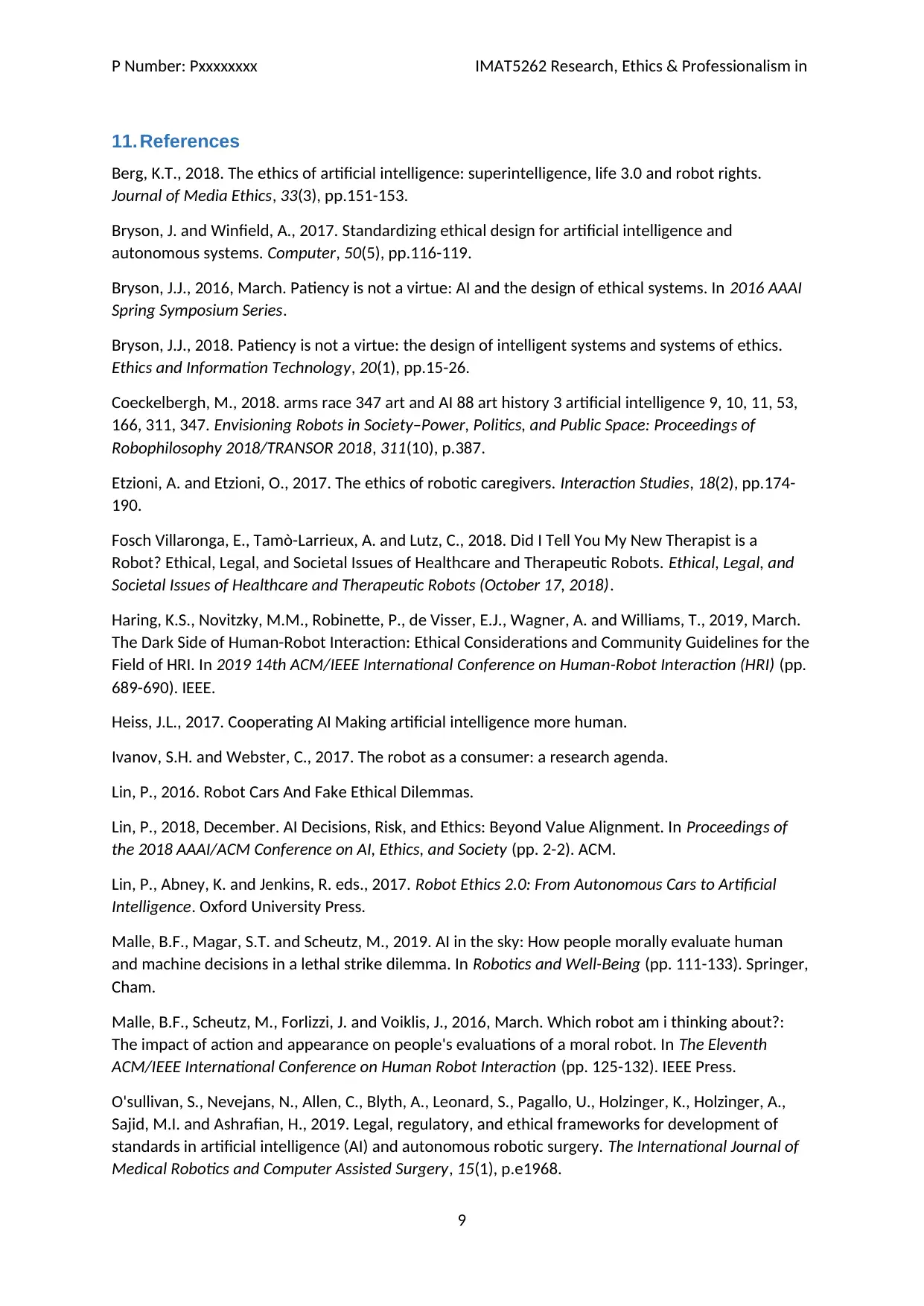
P Number: Pxxxxxxxx IMAT5262 Research, Ethics & Professionalism in
11. References
Berg, K.T., 2018. The ethics of artificial intelligence: superintelligence, life 3.0 and robot rights.
Journal of Media Ethics, 33(3), pp.151-153.
Bryson, J. and Winfield, A., 2017. Standardizing ethical design for artificial intelligence and
autonomous systems. Computer, 50(5), pp.116-119.
Bryson, J.J., 2016, March. Patiency is not a virtue: AI and the design of ethical systems. In 2016 AAAI
Spring Symposium Series.
Bryson, J.J., 2018. Patiency is not a virtue: the design of intelligent systems and systems of ethics.
Ethics and Information Technology, 20(1), pp.15-26.
Coeckelbergh, M., 2018. arms race 347 art and AI 88 art history 3 artificial intelligence 9, 10, 11, 53,
166, 311, 347. Envisioning Robots in Society–Power, Politics, and Public Space: Proceedings of
Robophilosophy 2018/TRANSOR 2018, 311(10), p.387.
Etzioni, A. and Etzioni, O., 2017. The ethics of robotic caregivers. Interaction Studies, 18(2), pp.174-
190.
Fosch Villaronga, E., Tamò-Larrieux, A. and Lutz, C., 2018. Did I Tell You My New Therapist is a
Robot? Ethical, Legal, and Societal Issues of Healthcare and Therapeutic Robots. Ethical, Legal, and
Societal Issues of Healthcare and Therapeutic Robots (October 17, 2018).
Haring, K.S., Novitzky, M.M., Robinette, P., de Visser, E.J., Wagner, A. and Williams, T., 2019, March.
The Dark Side of Human-Robot Interaction: Ethical Considerations and Community Guidelines for the
Field of HRI. In 2019 14th ACM/IEEE International Conference on Human-Robot Interaction (HRI) (pp.
689-690). IEEE.
Heiss, J.L., 2017. Cooperating AI Making artificial intelligence more human.
Ivanov, S.H. and Webster, C., 2017. The robot as a consumer: a research agenda.
Lin, P., 2016. Robot Cars And Fake Ethical Dilemmas.
Lin, P., 2018, December. AI Decisions, Risk, and Ethics: Beyond Value Alignment. In Proceedings of
the 2018 AAAI/ACM Conference on AI, Ethics, and Society (pp. 2-2). ACM.
Lin, P., Abney, K. and Jenkins, R. eds., 2017. Robot Ethics 2.0: From Autonomous Cars to Artificial
Intelligence. Oxford University Press.
Malle, B.F., Magar, S.T. and Scheutz, M., 2019. AI in the sky: How people morally evaluate human
and machine decisions in a lethal strike dilemma. In Robotics and Well-Being (pp. 111-133). Springer,
Cham.
Malle, B.F., Scheutz, M., Forlizzi, J. and Voiklis, J., 2016, March. Which robot am i thinking about?:
The impact of action and appearance on people's evaluations of a moral robot. In The Eleventh
ACM/IEEE International Conference on Human Robot Interaction (pp. 125-132). IEEE Press.
O'sullivan, S., Nevejans, N., Allen, C., Blyth, A., Leonard, S., Pagallo, U., Holzinger, K., Holzinger, A.,
Sajid, M.I. and Ashrafian, H., 2019. Legal, regulatory, and ethical frameworks for development of
standards in artificial intelligence (AI) and autonomous robotic surgery. The International Journal of
Medical Robotics and Computer Assisted Surgery, 15(1), p.e1968.
9
11. References
Berg, K.T., 2018. The ethics of artificial intelligence: superintelligence, life 3.0 and robot rights.
Journal of Media Ethics, 33(3), pp.151-153.
Bryson, J. and Winfield, A., 2017. Standardizing ethical design for artificial intelligence and
autonomous systems. Computer, 50(5), pp.116-119.
Bryson, J.J., 2016, March. Patiency is not a virtue: AI and the design of ethical systems. In 2016 AAAI
Spring Symposium Series.
Bryson, J.J., 2018. Patiency is not a virtue: the design of intelligent systems and systems of ethics.
Ethics and Information Technology, 20(1), pp.15-26.
Coeckelbergh, M., 2018. arms race 347 art and AI 88 art history 3 artificial intelligence 9, 10, 11, 53,
166, 311, 347. Envisioning Robots in Society–Power, Politics, and Public Space: Proceedings of
Robophilosophy 2018/TRANSOR 2018, 311(10), p.387.
Etzioni, A. and Etzioni, O., 2017. The ethics of robotic caregivers. Interaction Studies, 18(2), pp.174-
190.
Fosch Villaronga, E., Tamò-Larrieux, A. and Lutz, C., 2018. Did I Tell You My New Therapist is a
Robot? Ethical, Legal, and Societal Issues of Healthcare and Therapeutic Robots. Ethical, Legal, and
Societal Issues of Healthcare and Therapeutic Robots (October 17, 2018).
Haring, K.S., Novitzky, M.M., Robinette, P., de Visser, E.J., Wagner, A. and Williams, T., 2019, March.
The Dark Side of Human-Robot Interaction: Ethical Considerations and Community Guidelines for the
Field of HRI. In 2019 14th ACM/IEEE International Conference on Human-Robot Interaction (HRI) (pp.
689-690). IEEE.
Heiss, J.L., 2017. Cooperating AI Making artificial intelligence more human.
Ivanov, S.H. and Webster, C., 2017. The robot as a consumer: a research agenda.
Lin, P., 2016. Robot Cars And Fake Ethical Dilemmas.
Lin, P., 2018, December. AI Decisions, Risk, and Ethics: Beyond Value Alignment. In Proceedings of
the 2018 AAAI/ACM Conference on AI, Ethics, and Society (pp. 2-2). ACM.
Lin, P., Abney, K. and Jenkins, R. eds., 2017. Robot Ethics 2.0: From Autonomous Cars to Artificial
Intelligence. Oxford University Press.
Malle, B.F., Magar, S.T. and Scheutz, M., 2019. AI in the sky: How people morally evaluate human
and machine decisions in a lethal strike dilemma. In Robotics and Well-Being (pp. 111-133). Springer,
Cham.
Malle, B.F., Scheutz, M., Forlizzi, J. and Voiklis, J., 2016, March. Which robot am i thinking about?:
The impact of action and appearance on people's evaluations of a moral robot. In The Eleventh
ACM/IEEE International Conference on Human Robot Interaction (pp. 125-132). IEEE Press.
O'sullivan, S., Nevejans, N., Allen, C., Blyth, A., Leonard, S., Pagallo, U., Holzinger, K., Holzinger, A.,
Sajid, M.I. and Ashrafian, H., 2019. Legal, regulatory, and ethical frameworks for development of
standards in artificial intelligence (AI) and autonomous robotic surgery. The International Journal of
Medical Robotics and Computer Assisted Surgery, 15(1), p.e1968.
9
Secure Best Marks with AI Grader
Need help grading? Try our AI Grader for instant feedback on your assignments.
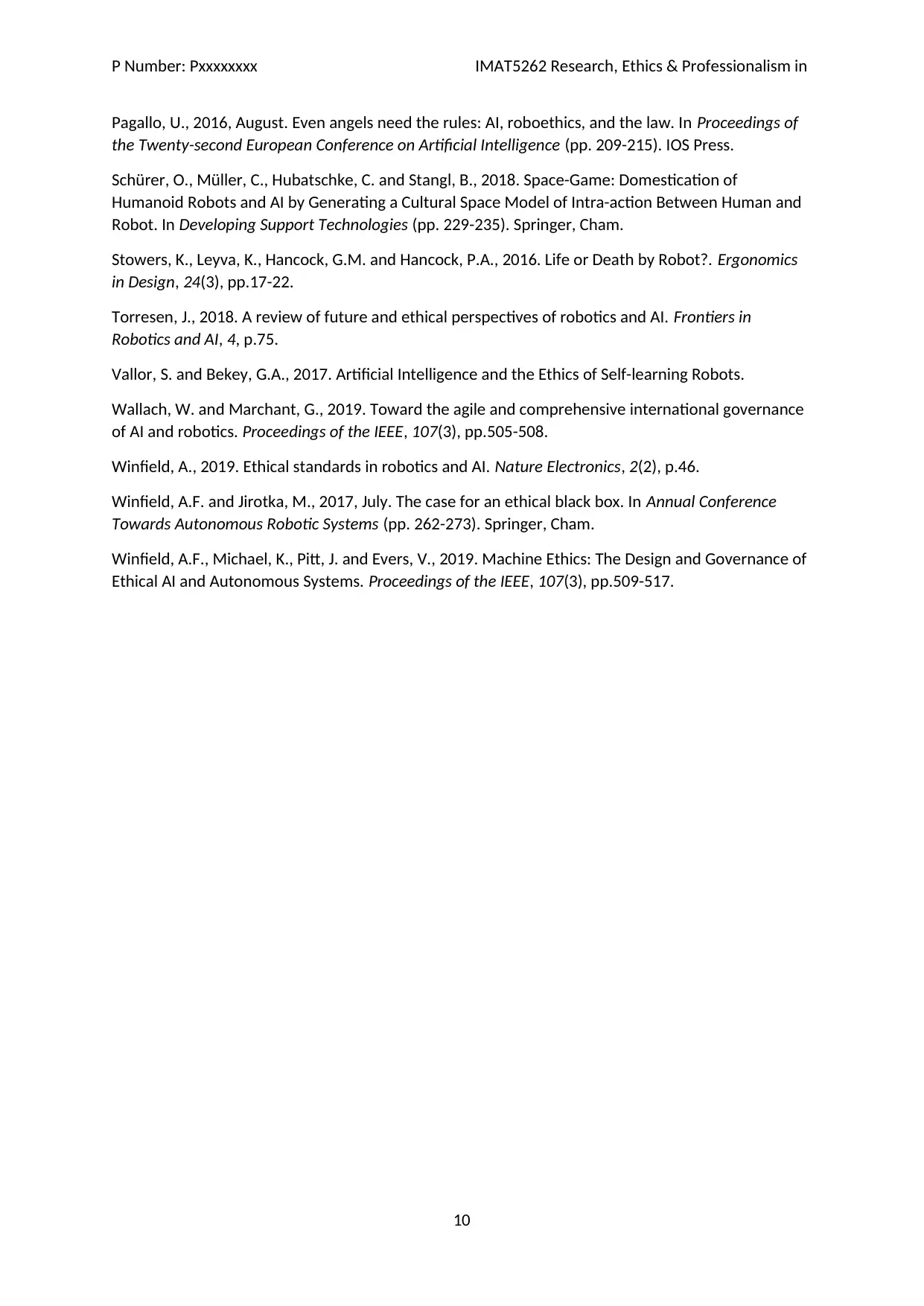
P Number: Pxxxxxxxx IMAT5262 Research, Ethics & Professionalism in
Pagallo, U., 2016, August. Even angels need the rules: AI, roboethics, and the law. In Proceedings of
the Twenty-second European Conference on Artificial Intelligence (pp. 209-215). IOS Press.
Schürer, O., Müller, C., Hubatschke, C. and Stangl, B., 2018. Space-Game: Domestication of
Humanoid Robots and AI by Generating a Cultural Space Model of Intra-action Between Human and
Robot. In Developing Support Technologies (pp. 229-235). Springer, Cham.
Stowers, K., Leyva, K., Hancock, G.M. and Hancock, P.A., 2016. Life or Death by Robot?. Ergonomics
in Design, 24(3), pp.17-22.
Torresen, J., 2018. A review of future and ethical perspectives of robotics and AI. Frontiers in
Robotics and AI, 4, p.75.
Vallor, S. and Bekey, G.A., 2017. Artificial Intelligence and the Ethics of Self-learning Robots.
Wallach, W. and Marchant, G., 2019. Toward the agile and comprehensive international governance
of AI and robotics. Proceedings of the IEEE, 107(3), pp.505-508.
Winfield, A., 2019. Ethical standards in robotics and AI. Nature Electronics, 2(2), p.46.
Winfield, A.F. and Jirotka, M., 2017, July. The case for an ethical black box. In Annual Conference
Towards Autonomous Robotic Systems (pp. 262-273). Springer, Cham.
Winfield, A.F., Michael, K., Pitt, J. and Evers, V., 2019. Machine Ethics: The Design and Governance of
Ethical AI and Autonomous Systems. Proceedings of the IEEE, 107(3), pp.509-517.
10
Pagallo, U., 2016, August. Even angels need the rules: AI, roboethics, and the law. In Proceedings of
the Twenty-second European Conference on Artificial Intelligence (pp. 209-215). IOS Press.
Schürer, O., Müller, C., Hubatschke, C. and Stangl, B., 2018. Space-Game: Domestication of
Humanoid Robots and AI by Generating a Cultural Space Model of Intra-action Between Human and
Robot. In Developing Support Technologies (pp. 229-235). Springer, Cham.
Stowers, K., Leyva, K., Hancock, G.M. and Hancock, P.A., 2016. Life or Death by Robot?. Ergonomics
in Design, 24(3), pp.17-22.
Torresen, J., 2018. A review of future and ethical perspectives of robotics and AI. Frontiers in
Robotics and AI, 4, p.75.
Vallor, S. and Bekey, G.A., 2017. Artificial Intelligence and the Ethics of Self-learning Robots.
Wallach, W. and Marchant, G., 2019. Toward the agile and comprehensive international governance
of AI and robotics. Proceedings of the IEEE, 107(3), pp.505-508.
Winfield, A., 2019. Ethical standards in robotics and AI. Nature Electronics, 2(2), p.46.
Winfield, A.F. and Jirotka, M., 2017, July. The case for an ethical black box. In Annual Conference
Towards Autonomous Robotic Systems (pp. 262-273). Springer, Cham.
Winfield, A.F., Michael, K., Pitt, J. and Evers, V., 2019. Machine Ethics: The Design and Governance of
Ethical AI and Autonomous Systems. Proceedings of the IEEE, 107(3), pp.509-517.
10

12. Appendices
12.1. Appendix A
Project Plan – Gantt chart
ID Task
Mode
Task Name Duration Start Finish
1 AI and Robotics 56 days Wed 01-05-19 Wed 17-07-19
2 Phase 1 10 days Wed 01-05-19 Tue 14-05-19
3 Topic selection 2 days Wed 01-05-19 Thu 02-05-19
4 Literature Review 2 days Fri 03-05-19 Mon 06-05-19
5 Documentation 5 days Tue 07-05-19 Mon 13-05-19
6 Evaluation 1 day Tue 14-05-19 Tue 14-05-19
7 Phase 2 11 days Tue 07-05-19 Tue 21-05-19
8 Pilot surveys 5 days Tue 07-05-19 Mon 13-05-19
9 Pilot interview 1 day Tue 14-05-19 Tue 14-05-19
10 Amend survey 5 days Wed 15-05-19 Tue 21-05-19
11 Phase 3 5 days Wed 22-05-19 Tue 28-05-19
12 Primary Data
collection
5 days Wed 22-05-19 Tue 28-05-19
13 Phase 4 36 days Wed 29-05-19 Wed 17-07-19
14 Analyse survey 30 days Wed 29-05-19 Tue 09-07-19
15 Critical Evaluation
of data
5 days Wed 10-07-19 Tue 16-07-19
16 Report draft 1 day Wed 17-07-19 Wed 17-07-19
28 02 06 10 14 18 22 26 30 03 07 11 15 19 23 27 01 05 09 13 17 21 25 29 02 06
22 Apr '19 06 May '19 20 May '19 03 Jun '19 17 Jun '19 01 Jul '19 15 Jul '19 29 Jul '19
12.1. Appendix A
Project Plan – Gantt chart
ID Task
Mode
Task Name Duration Start Finish
1 AI and Robotics 56 days Wed 01-05-19 Wed 17-07-19
2 Phase 1 10 days Wed 01-05-19 Tue 14-05-19
3 Topic selection 2 days Wed 01-05-19 Thu 02-05-19
4 Literature Review 2 days Fri 03-05-19 Mon 06-05-19
5 Documentation 5 days Tue 07-05-19 Mon 13-05-19
6 Evaluation 1 day Tue 14-05-19 Tue 14-05-19
7 Phase 2 11 days Tue 07-05-19 Tue 21-05-19
8 Pilot surveys 5 days Tue 07-05-19 Mon 13-05-19
9 Pilot interview 1 day Tue 14-05-19 Tue 14-05-19
10 Amend survey 5 days Wed 15-05-19 Tue 21-05-19
11 Phase 3 5 days Wed 22-05-19 Tue 28-05-19
12 Primary Data
collection
5 days Wed 22-05-19 Tue 28-05-19
13 Phase 4 36 days Wed 29-05-19 Wed 17-07-19
14 Analyse survey 30 days Wed 29-05-19 Tue 09-07-19
15 Critical Evaluation
of data
5 days Wed 10-07-19 Tue 16-07-19
16 Report draft 1 day Wed 17-07-19 Wed 17-07-19
28 02 06 10 14 18 22 26 30 03 07 11 15 19 23 27 01 05 09 13 17 21 25 29 02 06
22 Apr '19 06 May '19 20 May '19 03 Jun '19 17 Jun '19 01 Jul '19 15 Jul '19 29 Jul '19

ID
1
2
3
4
5
6
7
8
9
10
11
12
13
14
15
16
28 02 06 10 14 18 22 26 30 03 07 11 15 19 23 27 01 05 09 13 17 21 25 29 02 06
22 Apr '19 06 May '19 20 May '19 03 Jun '19 17 Jun '19 01 Jul '19 15 Jul '19 29 Jul '19
1
2
3
4
5
6
7
8
9
10
11
12
13
14
15
16
28 02 06 10 14 18 22 26 30 03 07 11 15 19 23 27 01 05 09 13 17 21 25 29 02 06
22 Apr '19 06 May '19 20 May '19 03 Jun '19 17 Jun '19 01 Jul '19 15 Jul '19 29 Jul '19
Paraphrase This Document
Need a fresh take? Get an instant paraphrase of this document with our AI Paraphraser
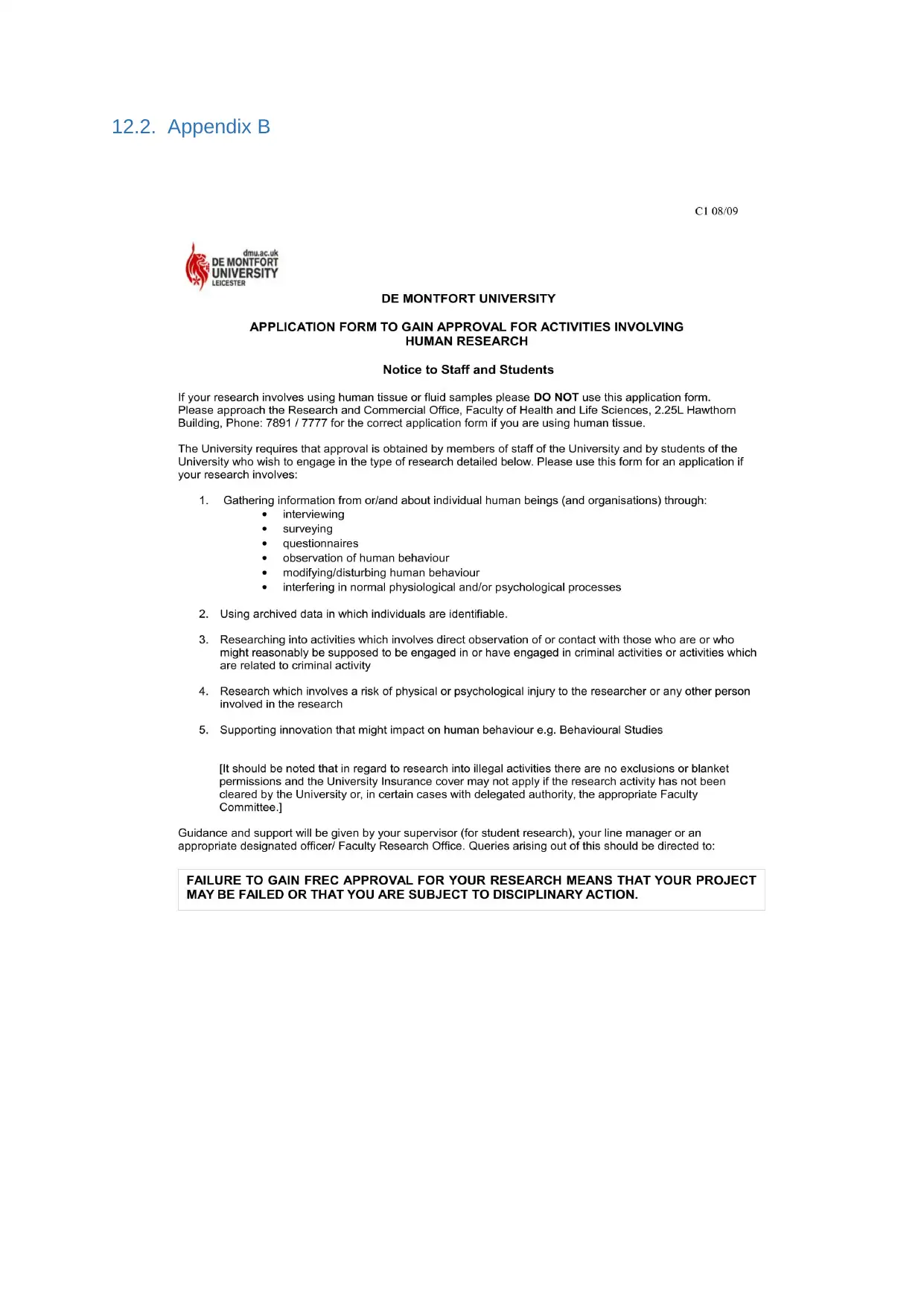
12.2. Appendix B
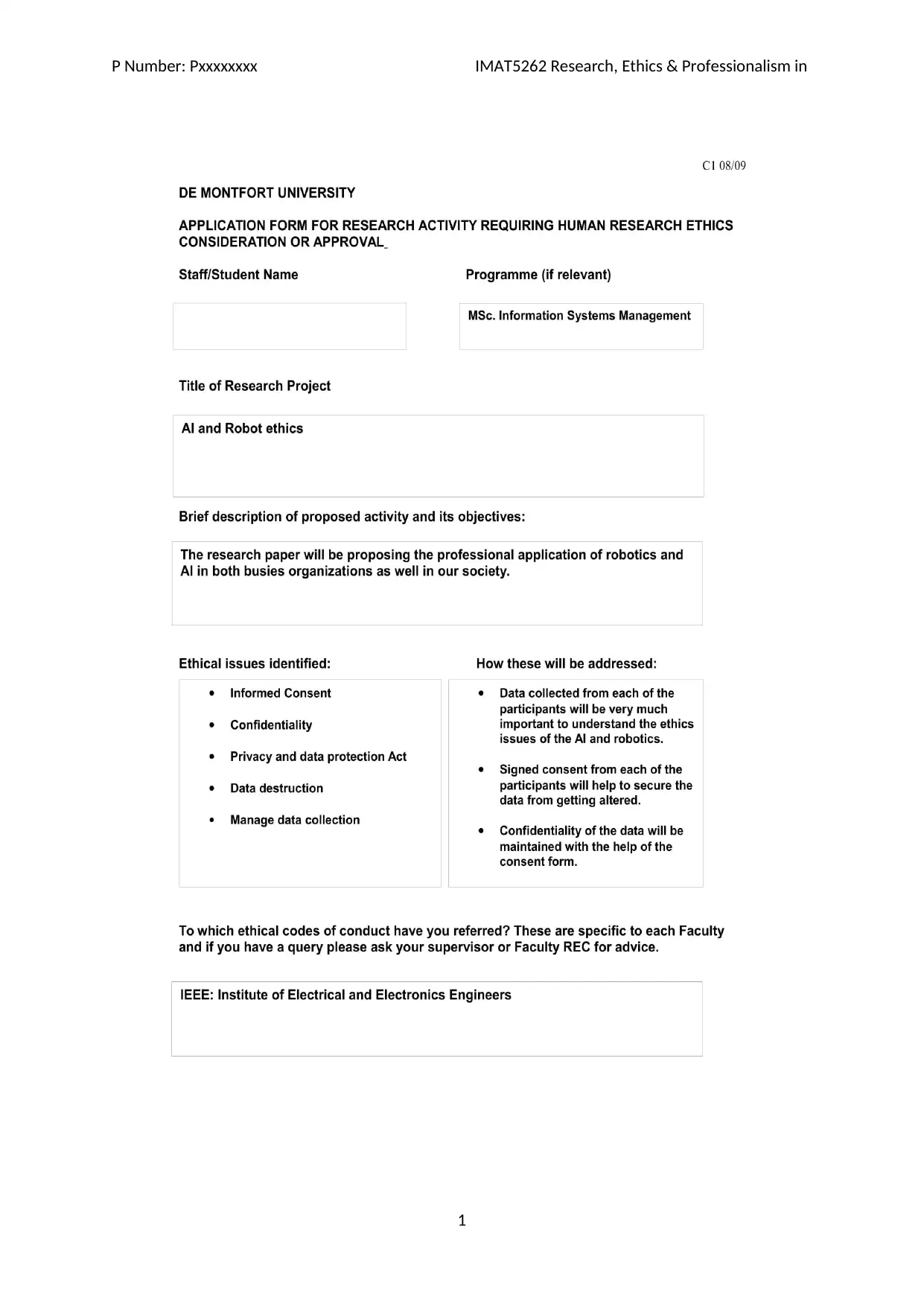
P Number: Pxxxxxxxx IMAT5262 Research, Ethics & Professionalism in
1
1
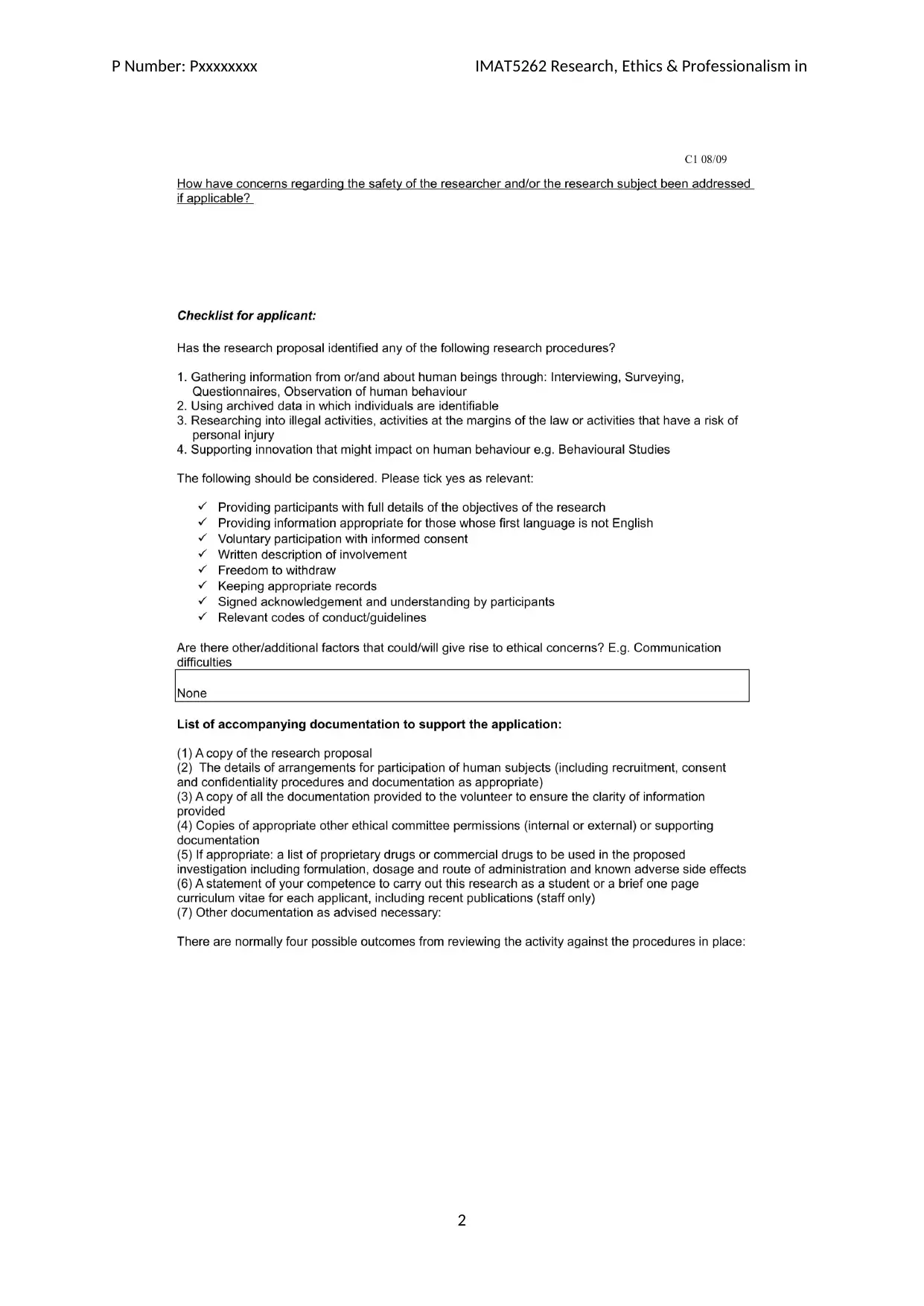
P Number: Pxxxxxxxx IMAT5262 Research, Ethics & Professionalism in
2
2
Secure Best Marks with AI Grader
Need help grading? Try our AI Grader for instant feedback on your assignments.
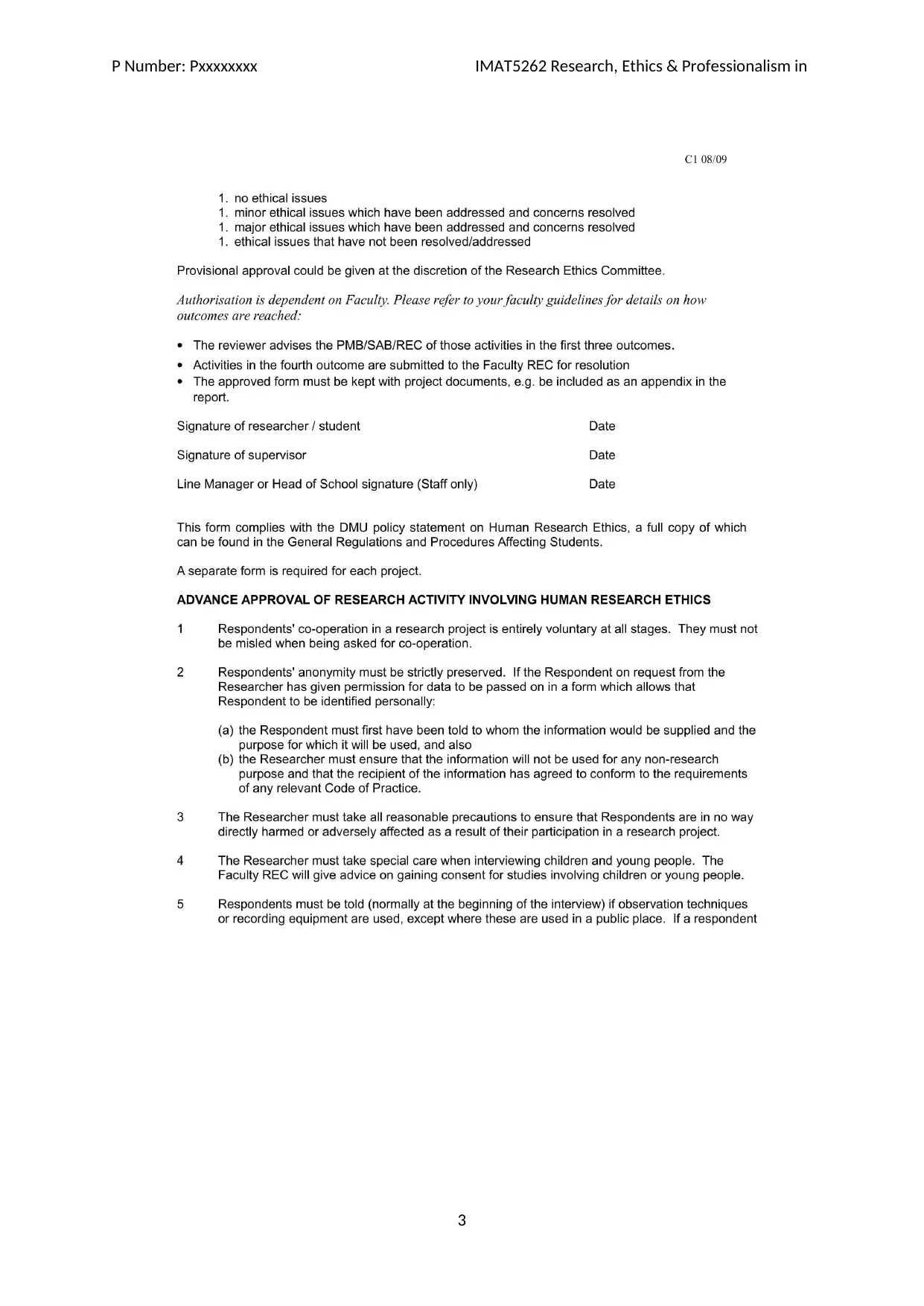
P Number: Pxxxxxxxx IMAT5262 Research, Ethics & Professionalism in
3
3

P Number: Pxxxxxxxx IMAT5262 Research, Ethics & Professionalism in
4
4
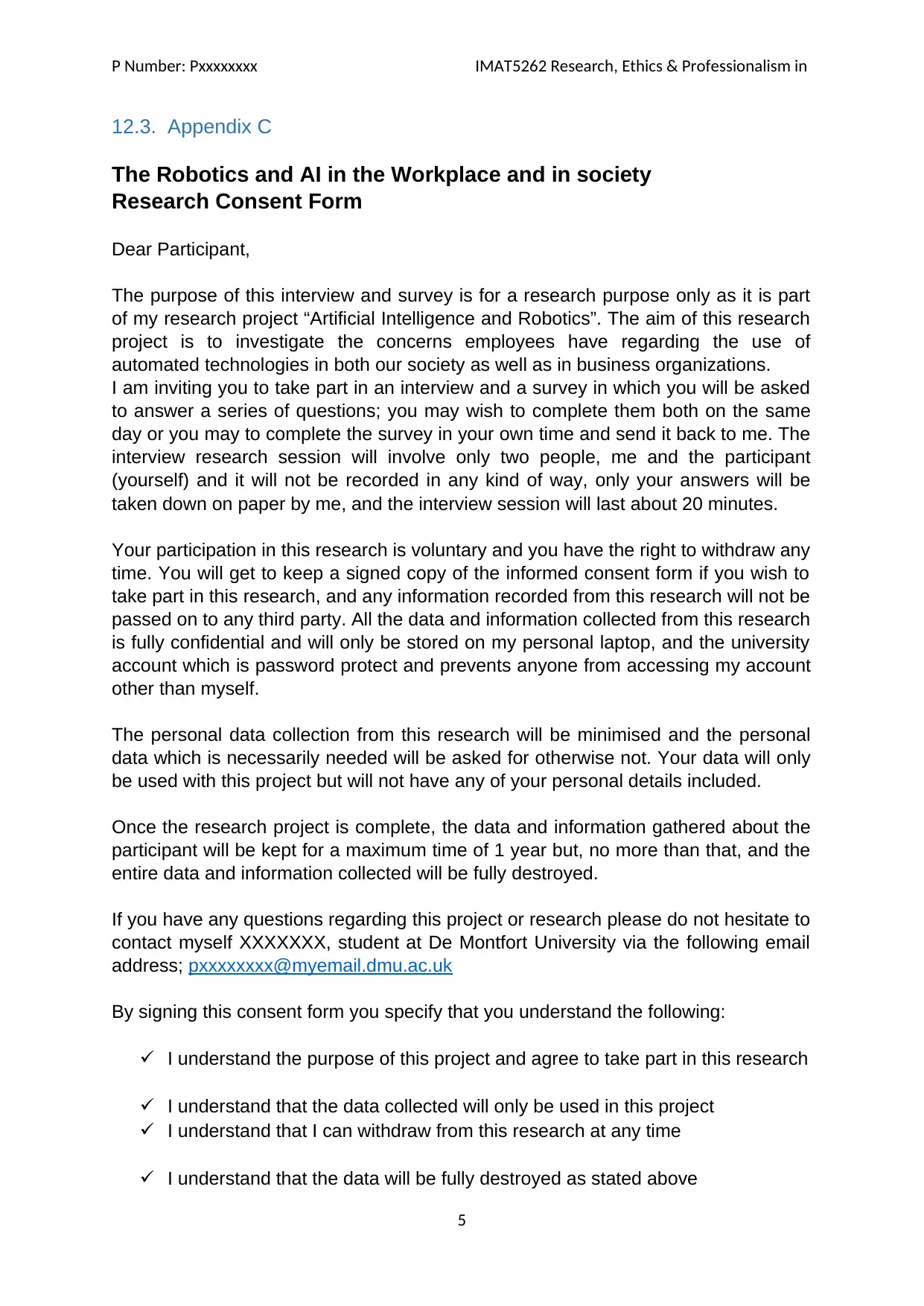
P Number: Pxxxxxxxx IMAT5262 Research, Ethics & Professionalism in
12.3. Appendix C
The Robotics and AI in the Workplace and in society
Research Consent Form
Dear Participant,
The purpose of this interview and survey is for a research purpose only as it is part
of my research project “Artificial Intelligence and Robotics”. The aim of this research
project is to investigate the concerns employees have regarding the use of
automated technologies in both our society as well as in business organizations.
I am inviting you to take part in an interview and a survey in which you will be asked
to answer a series of questions; you may wish to complete them both on the same
day or you may to complete the survey in your own time and send it back to me. The
interview research session will involve only two people, me and the participant
(yourself) and it will not be recorded in any kind of way, only your answers will be
taken down on paper by me, and the interview session will last about 20 minutes.
Your participation in this research is voluntary and you have the right to withdraw any
time. You will get to keep a signed copy of the informed consent form if you wish to
take part in this research, and any information recorded from this research will not be
passed on to any third party. All the data and information collected from this research
is fully confidential and will only be stored on my personal laptop, and the university
account which is password protect and prevents anyone from accessing my account
other than myself.
The personal data collection from this research will be minimised and the personal
data which is necessarily needed will be asked for otherwise not. Your data will only
be used with this project but will not have any of your personal details included.
Once the research project is complete, the data and information gathered about the
participant will be kept for a maximum time of 1 year but, no more than that, and the
entire data and information collected will be fully destroyed.
If you have any questions regarding this project or research please do not hesitate to
contact myself XXXXXXX, student at De Montfort University via the following email
address; pxxxxxxxx@myemail.dmu.ac.uk
By signing this consent form you specify that you understand the following:
I understand the purpose of this project and agree to take part in this research
I understand that the data collected will only be used in this project
I understand that I can withdraw from this research at any time
I understand that the data will be fully destroyed as stated above
5
12.3. Appendix C
The Robotics and AI in the Workplace and in society
Research Consent Form
Dear Participant,
The purpose of this interview and survey is for a research purpose only as it is part
of my research project “Artificial Intelligence and Robotics”. The aim of this research
project is to investigate the concerns employees have regarding the use of
automated technologies in both our society as well as in business organizations.
I am inviting you to take part in an interview and a survey in which you will be asked
to answer a series of questions; you may wish to complete them both on the same
day or you may to complete the survey in your own time and send it back to me. The
interview research session will involve only two people, me and the participant
(yourself) and it will not be recorded in any kind of way, only your answers will be
taken down on paper by me, and the interview session will last about 20 minutes.
Your participation in this research is voluntary and you have the right to withdraw any
time. You will get to keep a signed copy of the informed consent form if you wish to
take part in this research, and any information recorded from this research will not be
passed on to any third party. All the data and information collected from this research
is fully confidential and will only be stored on my personal laptop, and the university
account which is password protect and prevents anyone from accessing my account
other than myself.
The personal data collection from this research will be minimised and the personal
data which is necessarily needed will be asked for otherwise not. Your data will only
be used with this project but will not have any of your personal details included.
Once the research project is complete, the data and information gathered about the
participant will be kept for a maximum time of 1 year but, no more than that, and the
entire data and information collected will be fully destroyed.
If you have any questions regarding this project or research please do not hesitate to
contact myself XXXXXXX, student at De Montfort University via the following email
address; pxxxxxxxx@myemail.dmu.ac.uk
By signing this consent form you specify that you understand the following:
I understand the purpose of this project and agree to take part in this research
I understand that the data collected will only be used in this project
I understand that I can withdraw from this research at any time
I understand that the data will be fully destroyed as stated above
5
Paraphrase This Document
Need a fresh take? Get an instant paraphrase of this document with our AI Paraphraser
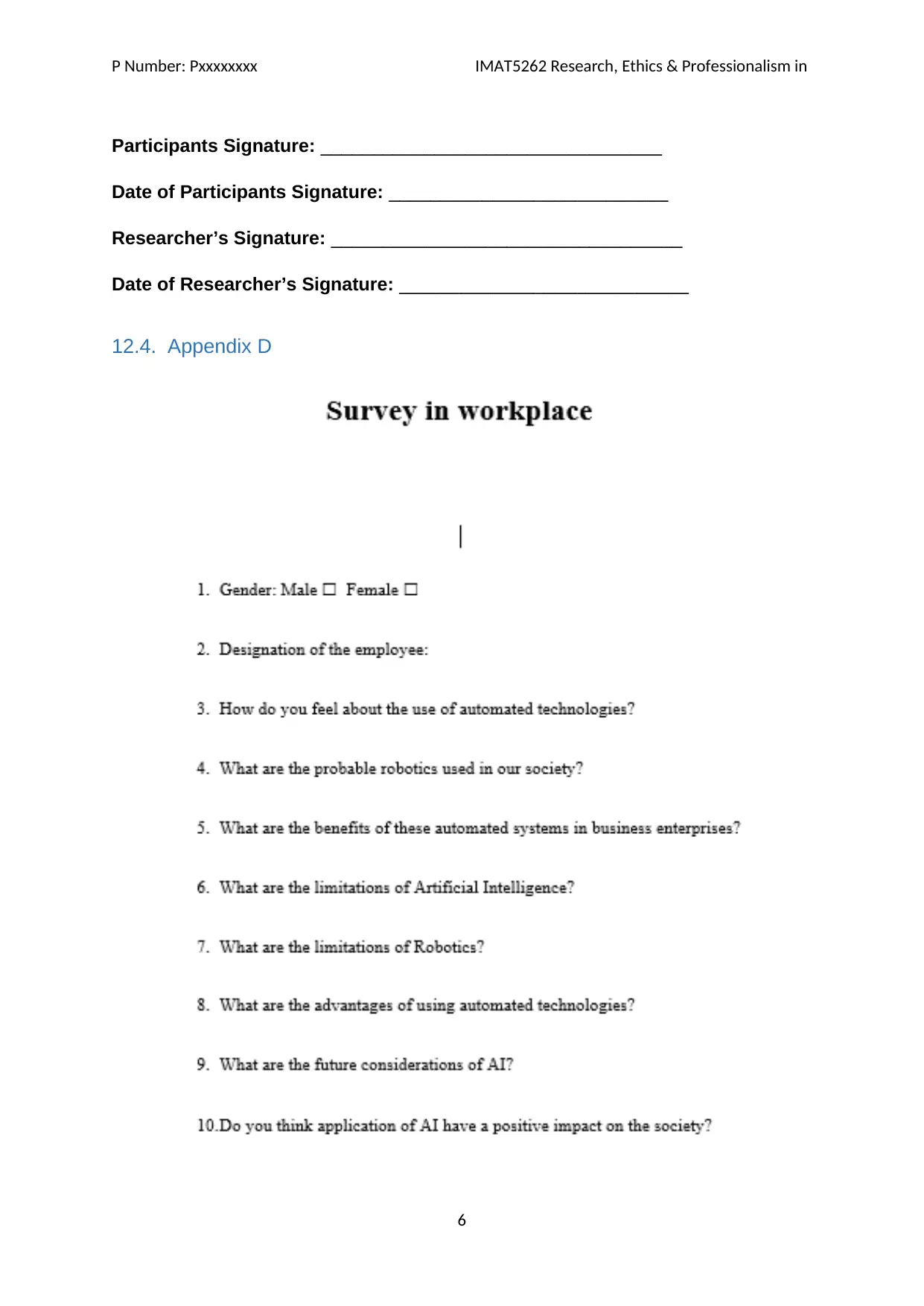
P Number: Pxxxxxxxx IMAT5262 Research, Ethics & Professionalism in
Participants Signature: _________________________________
Date of Participants Signature: ___________________________
Researcher’s Signature: __________________________________
Date of Researcher’s Signature: ____________________________
12.4. Appendix D
6
Participants Signature: _________________________________
Date of Participants Signature: ___________________________
Researcher’s Signature: __________________________________
Date of Researcher’s Signature: ____________________________
12.4. Appendix D
6
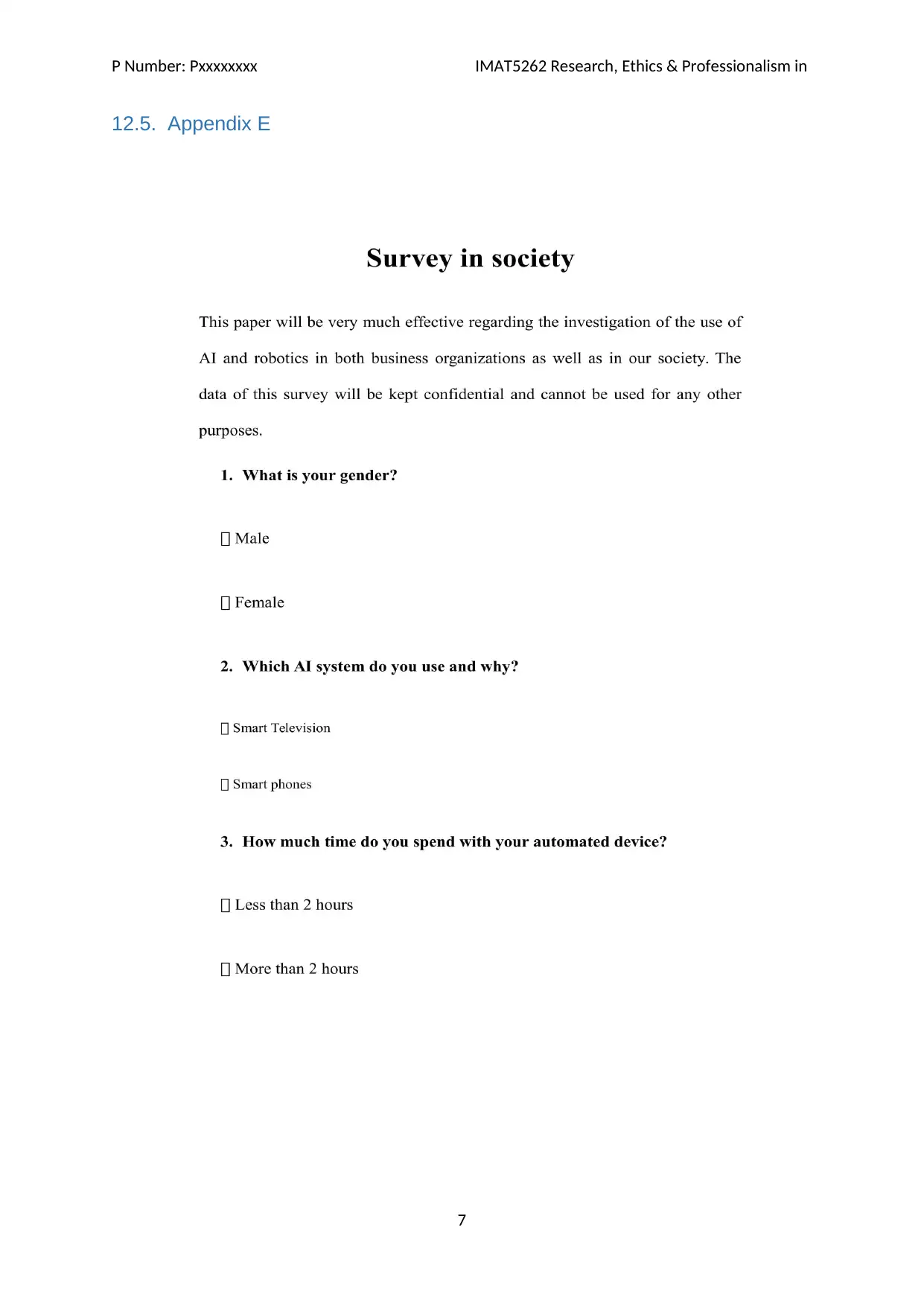
P Number: Pxxxxxxxx IMAT5262 Research, Ethics & Professionalism in
12.5. Appendix E
7
12.5. Appendix E
7
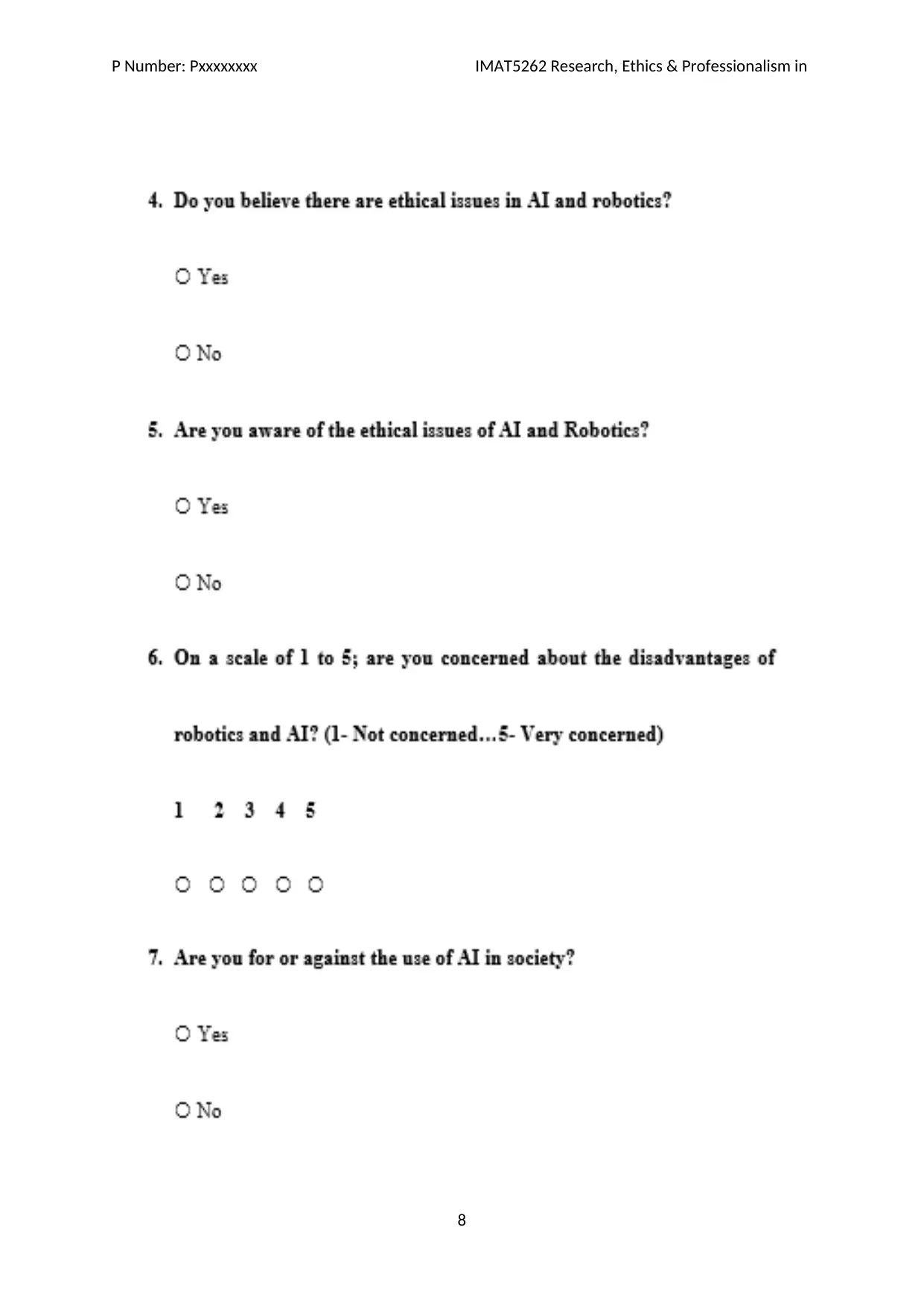
P Number: Pxxxxxxxx IMAT5262 Research, Ethics & Professionalism in
8
8
Secure Best Marks with AI Grader
Need help grading? Try our AI Grader for instant feedback on your assignments.

P Number: Pxxxxxxxx IMAT5262 Research, Ethics & Professionalism in
9
9
1 out of 23
Related Documents
Your All-in-One AI-Powered Toolkit for Academic Success.
+13062052269
info@desklib.com
Available 24*7 on WhatsApp / Email
![[object Object]](/_next/static/media/star-bottom.7253800d.svg)
Unlock your academic potential
© 2024 | Zucol Services PVT LTD | All rights reserved.





